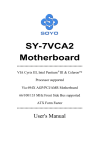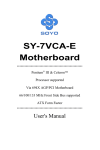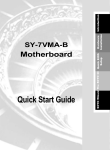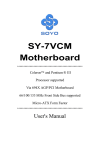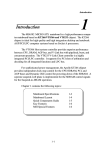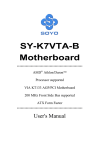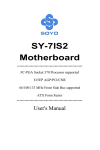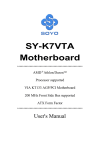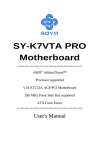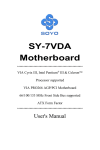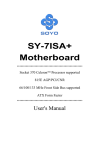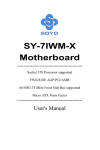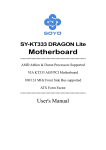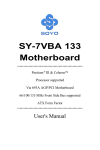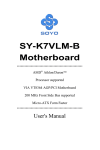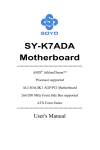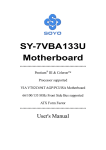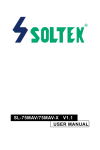Download SY-7VMA-B Motherboard
Transcript
SY-7VMA-B Motherboard **************************************************** Pentium ® III & Celeron Processor supported Via VT8605 AGP/PCI/ISA Motherboard 66/100/133 MHz Front Side Bus supported ATX Form Factor **************************************************** User's Manual SOYO ™ SY-7VMA-B Copyright © 2000 by Soyo Computer Inc. Trademarks: Soyo is the registered trademark of Soyo Computer Inc. All trademarks are the properties of their owners. Product Rights: All names of the product and corporate mentioned in this publication are used for identification purposes only. The registered trademarks and copyrights belong to their respective companies. Copyright Notice: All rights reserved. This manual has been copyrighted by Soyo Computer Inc. No part of this manual may be reproduced, transmitted, transcribed, translated into any other language, or stored in a retrieval system, in any form or by any means, such as by electronic, mechanical, magnetic, optical, chemical, manual or otherwise, without permission in writing from Soyo Computer Inc. Disclaimer: Soyo Computer Inc. makes no representations or warranties regarding the contents of this manual. We reserve the right to amend the manual or revise the specifications of the product described in it from time to time without obligation to notify any person of such revision or amend. The information contained in this manual is provided to our customers for general use. Customers should be aware that the personal computer field is subject to many patents. All of our customers should ensure that their use of our products does not infringe upon any patents. It is the policy of Soyo Computer Inc. to respect the valid patent rights of third parties and not to infringe upon or to cause others to infringe upon such rights. Restricted Rights Legend: Use, duplication, or disclosure by the Government is subject to restrictions set forth in subparagraph (c)(1)(ii) of the Rights in Technical Data and Computer Software clause at 252.277-7013. About This Guide: This Quick Start Guide can help system manufacturers and end users in setting up and installing the Motherboard. Information in this guide has been carefully checked for reliability; however, to the correctness of the contents there is no guarantee given. The information in this document is subject to amend without notice. For further information, please visit our Web Site on the Internet. The address is "http://www.soyo.com.tw". Tested To Comply With FCC Standards FOR HOME OR OFFICE USE C FC Edition: November 2000 Version 1.0 7VMA-B SERIAL 100% ii POST CONSUMER RECYCLED PAPER Table of Contents SY-7VMA-B Table of Contents CHAPTER 1 MOTHERBOARD DESCRIPTION .............................1 1-1 INTRODUCTION ...........................................................1 1-2 1-3 1-4 1-5 1-6 1-7 1-8 1-9 KEY FEATURES ............................................................1 HANDLING THE MOTHERBOARD .............................5 ELECTROSTATIC DISCHARGE PRECAUTIONS ........5 SY-7VMA-B MOTHERBOARD LAYOUT.....................6 SY-7VMA-B MOTHERBOARD COMPONENTS ..........7 MICROPROCESSOR......................................................9 CHIPSET FEATURES...................................................10 CHIPSET ......................................................................11 1-10 1-11 1-12 I/O INTERFACE CONTROLLER .................................17 HARDWARE MONITOR..............................................19 WAKE ON LAN TECHNOLOGY.................................20 CHAPTER 2 HARDWARE INSTALLATION..................................21 2-1 2-2 2-3 PREPARATIONS ..........................................................21 UNPACKING THE MOTHERBOARD .........................22 INSTALLATION GUIDE ..............................................23 2-3.1 CPU Fan Installation.................................................. 24 2-3.2 SDRAM Memory Module Installation......................... 27 2-3.3 Motherboard Connector.............................................. 29 3-3.4 CMOS Clearing (JP5)................................................. 43 2-3.5 Power On ................................................................... 44 2-3.6 Quick BIOS Setup ....................................................... 45 2-3.7 Troubleshooting at First Start ..................................... 47 2-3.8 Power Off................................................................... 50 CHAPTER 3 BIOS SETUP UTILITY ..............................................51 3-1 3-2 SOYO COMBO SETUP.................................................54 STANDARD CMOS SETUP ..........................................57 iii Table of Contents 3-3 3-4 3-5 3-6 3-7 3-8 3-9 3-10 3-11 3-12 3-13 3-1 SY-7VMA-B ADVANCED BIOS FEATURES.....................................60 ADVANCED CHIPSET FEATURES..............................64 INTEGRATED PERIPHERALS .....................................69 POWER MANAGEMENT SETUP ................................74 PNP/PCI CONFIGURATION SETUP.............................78 PC HEALTH STATUS....................................................81 LOAD FAIL-SAFE DEFAULTS.....................................83 LOAD OPTIMIZED DEFAULTS...................................84 SUPERVISOR PASSWORD...........................................85 USER PASSWORD........................................................86 IDE HDD AUTO DETECTION .....................................87 BOOT MENU ................................................................88 CHAPTER 4 DRIVERS INSTALLATION .......................................89 CHAPTER 5 SOYO WIZARD ON HAND (WOH) UTILITY .........94 iv Motherboard Description SY-7VMA-B Chapter 1 MOTHERBOARD DESCRIPTION 1-1 INTRODUCTION The SY-7VMA-B AGP/PCI Motherboard is a high-performance Socket 370 supported ATX form-factor system board. The SY-7VMA-B uses VIA Chipset technology and supports Socket 370 class processors. This Motherboard is fully compatible with industry standards and adds many technical enhancements. 1-2 KEY FEATURES Ø CPU SUPPORT The SY-7VMA-B supports a wide range of INTEL CPUs: n FSB 133MHz: Intel Pentium ® III 533EBMHz~1.13GHz n FSB 100MHz: Intel Pentium ® III 500E~850 MHz n FSB 66MHz: Intel Celeron ® 400~700 MHz New released Intel Socket 370 CPUs will very likely be supported by the SY-7VMA-B as well. Ø CPU SETTINGS The SY-7VMA-B provides the user with a very complete and convenient CPU setting environment. The CPU settings are all adjusted through the special SOYO COMBO page in the BIOS, therefore rendering the use of jumpers obsolete. n CPU FSB Frequency The SY-7VMA-B supports an incredible wide range of CPU FSB frequency settings: 66, 75, 81, 83, 90, 95, 100, 105, 110, 112, 113, 115, 117, 118, 120, 122, 124, 126, 133, 135, 137, 138, 140, 142, 144, 150 and 155 MHz. This ensures that the SY-7VMA-B has an overwhelming overclocking potential. 1 Motherboard Description SY-7VMA-B n CPU Multiplier The SY-7VMA-B supports a wide range of multipliers: 2.0x, 2.5x, 3.0x, 3.5x, 4.0x, 4.5x, 5.0x, 5.5x, 6.0x, 6.5x, 7.0x, 7.5x and 8.0x Ø EXPANDABILITY The SY-7VMA-B provides all the standard expansion slots, and many more additional expansion features: u n n n u n n n n n n n n Expansion slots 1 x 32-bit bus master AGP slot 5 x 32-bit bus master PCI slots 1 x 16-bit ISA slots Enhanced IO Floppy disk controller 2x EIDE controllers with support for up to 4 Ultra DMA 33/66 /100 devices Standard/EPP/ECP parallel port 1 x 16550 compatible serial ports IrDA compatible infrared port 4x USB (Universal Serial Bus) connectors PS/2 mouse connector PS/2 keyboard connector 2 Motherboard Description Ø SY-7VMA-B ADVANCED FUNCTIONS The SY-7VMA-B supports advanced functions such as: n Wake-On-LAN Supports Wake-On-LAN (Some advanced network cards can wake the system up over the network, the WOL connector is provided by the SY-7VMA-B to support this function). n Multiple boot The SY-7VMA-B supports booting from devices such as CD-ROM. n Power on by modem or alarm If the SY-7VMA-B system is in suspend mode, it can be switched back on through the modem or RTC alarm through this function. This opens a lot of possibilities, such as remote access that switches the system on only after the modem receives a call. Ø FAIL SAFE The SY-7VMA-B comes with added functionality to make managing the system easy and safe u Hardware Monitor The integrated Hardware Monitor IC and Hardware doctor software enables the user to monitor system voltages, temperatures and FAN speeds. This makes sure that the user is full control of the system u Power Failure Resume Function This function can be set in the BIOS, and determines whether the system will automatically turn on again after a power failure. This function is indispensable for server systems that need to always be on line. Ø SOYO SUPER BONUS PACK 3 Motherboard Description Ø SY-7VMA-B COMPLIANCE The SY-7VMA-B complies with all important industry standards. The following underlines the reliability of the SY-7VMA-B, a motherboard to trust. n PC99, ACPI compliant Ø USER FRIENDLY n n n SOYO Combo Setup Jumperless design You can set up the following options trough the BIOS setting CPU FSB frequency CPU multiplier CPU Vcore voltage SDRAM Clock 4 Motherboard Description 1-3 SY-7VMA-B HANDLING THE MOTHERBOARD To avoid damage to your Motherboard, follow these simple rules while unpacking: Ø Before handling the Motherboard, ground yourself by grasping an unpainted portion of the system's metal chassis. Ø Remove the Motherboard from its anti-static packaging. Hold the Ø Motherboard by the edges and avoid touching its components. Check the Motherboard for damage. If any chip appears loose, press carefully to seat it firmly in its socket. Warning: Do not apply power if the Motherboard appears damaged. If there is damage to the board, contact your dealer immediately. 1-4 ELECTROSTATIC DISCHARGE PRECAUTIONS Make sure to ground yourself before handling the Motherboard or other system components. Electrostatic discharge can easily damage the components. Note that you must take special precautions when handling the Motherboard in dry or air-conditioned environment. To protect your equipment from electrostatic discharge, take the following precautions: Ø Do not remove the anti-static packaging until you are ready to install. Ø Ground yourself before removing any system component from its protective anti-static packaging. (To ground yourself, grasp the expansion slot covers or other unpainted portions of the computer chassis.) Ø Frequently ground yourself while working or use a grounding strap. Ø Handle the Motherboard by its edges and avoid touching its components. 5 Motherboard Description SY-7VMA-B 1-5 SY-7VMA-B MOTHERBOARD LAYOUT CPUFAN PS/2 KB PS/2 Mouse Connector Connector USB 1 3 Socket 370 1 USB 2 PRT COM A ATX Power VGA SDRAM FDC1 ® AGAME1 VT8605 AOUT1 SDRAM AIN1 CHAFAN2 DIMM3 DIMM 2 DIMM 1 1 AMIC1 4 3 1 1 4 1 1 AGP Slot CDIN1 CDIN2 1 1 IDE 1 IDE 2 5 1 SIRCON 3 CHAFAN1 PCI Slot #1 PCI Slot #2 JP5 VT82C686B CMOS Clear ® CODEC AC97 Jumper 3 1 1 1 USB3 PCI Slot #3 USB4 4 5 PCI Slot #4 3V Lithium Battery ISA Slot #1 HDD LED _ PWRBTReset + PCI Slot #5 _ + 3 Speaker Back Panel SY-7VMA-B Platform 6 _ + 1 Flash BIOS JP10 Power LED Motherboard Description SY-7VMA-B 1-6 SY-7VMA-B MOTHERBOARD COMPONENTS A B C D E W F SDRAM ® G SDRAM H I J V U T K L ® M S R N O Q P 7 Motherboard Description A B C D E F G H I J K L M N O P Q R S T U V W SY-7VMA-B ATX Power Supply Connector Socket 370 Connector Via PM133 North Bridge chip DIMM Banks CPU Cooling Fan Connector Bus Mastering e-IDE/ATAPI Ports Floppy Disk Drive (FDD) Port Chassis Cooling Fan Serial Infrared (IrDA) Device Header 32-bit AGP Slot Via 686B South Bridge Chip CMOS Clear Jumper USB Ports Flash BIOS Front panel connectors 3V Lithium Battery 16-bit ISA Slot Wake-On-LAN (WOL) Header 32-bit PCI Mastering Slots AC97 Codec Chip Chassis Cooling Fan CD-IN Connectors Back panel Connectors 8 Motherboard Description SY-7VMA-B 1-7 MICROPROCESSOR The motherboard supports a single Socket 370 processor. The processor’s VID pins automatically program the voltage regulator on the motherboard to the required processor voltage. In addition, the front side bus speed (100 MHz and 133 MHz) is automatically selected. The motherboard supports all current Socket 370 processor speeds, voltages, and bus frequencies. 1-7.1 Microprocessor Packaging The CPU is packaged in a 370 pin PGA package. A fan must be used to ensure adequate cooling. 1-7.2 Second Level Cache The second-level cache is located on the substrate of the CPU package. The cache includes 0KB/128KB or 512 KB of synchronous pipelined burst static RAM. All supported onboard memory can be cached. 1-7.3 Microprocessor Upgrades The motherboard can be upgraded with Socket 370 processors that run at higher speeds. When upgrading the processor, use the BIOS configuration mode to change the processor speed. 9 Motherboard Description SY-7VMA-B 1-8 CHIPSET FEATURES 1-8.1 VT8605 APOLLO PROSAVAGE PM133 l Defines Integrated Solutions for Value PC Desktops ¡ XHigh performance SMA North Bridge: Integrated VIA Apollo Pro133A and S3‘s Savage4TM in a single chip ¡ XThe “P6-bus Desktop PC” member of VIA’s Apollo ProSavage integrated graphics product line ¡ X64-bit Advanced Memory controller supporting PC100/PC133 SDRAM and VCM ¡ XAGP Expansion Interface supporting AGP 4x, 2x, or 1x external AGP graphics card upgrade l High Performance CPU Interface ¡ XSlot 1 (Intel ® Pentium ®II and Pentium III) and Socket 370 (VIA Technologies VIA-Cyrix-IIITM and Intel CeleronTM) ¡ X66/100/133 MHz CPU Front Side Bus (FSB) ¡ XBuilt-in Phase Lock Loop circuitry for optimal skew control within and between clocking regions ¡ XFive outstanding transactions (four In-Order Queue (IOQ) plus one output latch) ¡ XDynamic deferred transaction support l Advanced High-Performance DRAM Controller ¡ XDRAM interface runs synchronous (66/66, 100/100, 133/133) mode ¡ ¡ ¡ ¡ or pseudo-synchronous (66/100, 100/66, 100/133, 133/100) mode with FSB (for 66/66 operation, only external VGA is supported) Concurrent CPU, AGP, and PCI access XSupports standard SDRAM and VCM SDRAM memory types XSupport 3 DIMMs or 6 banks for up to 1.5 GB of DRAM (256Mb DRAM technology) X64-bit data width XSupports maximum 8-bank interleave (8 pages open simultaneously); banks are allocated based on LRU ¡ XSDRAM X-1-1-1-1-1-1-1 back-to-back accesses 10 Motherboard Description SY-7VMA-B l Accelerated Graphics Port (AGP) Controller ¡ XAGP Specification Rev. 2.0 compliant ¡ XSupports 266 MHz 4x mode for AD and SBA signaling ¡ XSupports SideBand Addressing (SBA) mode (non-multiplexed address/data) ¡ XPipelined split-transaction long-burst transfers up to 1GB/sec ¡ XIntelligent request reordering for maximum AGP bus utilization ¡ XAGP Expansion graphics override the integrated graphics by default with no SMA frame buffer 1-9 CHIPSET Ø VT8605 The VT8605 is a high performance, cost-effective and energy efficient SMA chip set for the implementation of AGP / PCI / LPC desktop personal computer systems with 66 MHz, 100 MHz and 133 MHz CPU host bus (“Front Side Bus”) frequencies and based on 64-bit Socket-370 (VIA-Cyrix-III and Intel Celeron) and Slot-1 (Intel Pentium II and Pentium-III) super-scalar processors. In other words, the VT8605 is the P6-bus version of the Apollo ProSavage integrated graphics product line targeted at desktop PCs, developed by the VIA / S3 joint venture. The VT8605 may also be referred to by product name PM133 in VIA and S3 marketing literature. The VT8605 integrates VIA VT82C694X system controller and S3 Savage4 2D/3D graphics accelerator into a single 552 BGA package. The VT8605 SMA system controller provides superior performance between the CPU, DRAM, AGP bus, and PCI bus with pipelined, burst, and concurrent operation. The VT8605 supports six banks of DRAMs up to 1.5Gbyte of system memory with 256Mbit DRAM technology. The DRAM controller supports standard Synchronous DRAM (SDRAM) and Virtual Channel SDRAM (VC SDRAM), in a flexible mix / match manner. The Synchronous DRAM interface allows zero wait state bursting between the DRAM and the data buffers at 66/100/133 MHz. The six banks of DRAM can be 11 Motherboard Description SY-7VMA-B composed of an arbitrary mixture of 1M / 2M / 4M / 8M / 16M / 32MxN DRAMs. The DRAM controller can run at either the host CPU bus frequency (66 /100 /133 MHz) or pseudo-synchronous to the CPU bus frequency (66/100/133 MHz) with built-in PLL timing control. The VT8605 system controller also supports full AGP v2.0 capability for maximum bus utilization including 1x/2x/4x mode transfers, SBA (SideBand Addressing), Flush/Fence commands, and pipelined grants. An eight level request queue plus a four level post-write request queue with thirty-two and sixteen quadwords of read and write data FIFO's respectively are included for deep pipelined and split AGP transactions. A single-level GART TLB with 16 full associative entries and flexible CPU / AGP / PCI remapping control is also provided for operation under protected mode operating environments. Both Windows-95 VXD and Windows-98 / Windows 2000 miniport drivers are supported for interoperability with integrated Savage4 graphics, AGP Expansion graphics, and DVD-capable multimedia accelerators. The VT8605 supports two 32-bit 3.3 / 5V system buses (one AGP and one PCI) that are synchronous / pseudo-synchronous to the CPU bus. The chip also contains a built-in bus-to-bus bridge to allow simultaneous concurrent operations on each bus. Five levels (doublewords) of post write buffers are included to allow for concurrent CPU and PCI operation. For PCI master operation, forty-eight levels (doublewords) of post write buffers and sixteen levels (doublewords) of prefetch buffers are included for concurrent PCI bus and DRAM/cache accesses. The chip also supports enhanced PCI bus commands such as Memory-Read-Line, Memory-ReadMultiple and Memory-Write-Invalid commands to minimize snoop overhead. In addition, advanced features are supported such as snoop ahead, snoop filtering, L1 write-back forward to PCI master, and L1 writeback merged with PCI post write buffers to minimize PCI master read latency and DRAM utilization. Delay transaction and read caching mechanisms are also implemented for further improvement of overall system performance. 12 Motherboard Description SY-7VMA-B The VT8605 also integrates S3 ®’s Savage4TM graphics accelerator into a single chip. The VT8605 brings mainstream graphics performance to the Value PC with leading-edge 2D, 3D and DVD video acceleration into a cost effective package. Based on its capabilities, the VT8605 is an ideal solution for the consumer, corporate desktop users and entry level professionals. The industry’s first integrated AGP 4X solution, the VT8605 combines AGP 4X with S3’s DX6 texture compression (S3TC) and massive 2Kx2K textures to deliver unprecedented 3D performance and image quality for the Value PC desktop market. The 352-pin VT8231 BGA PCI-LPC bridge supports four levels (doublewords) of line buffers, type F DMA transfers and delay transaction to allow efficient PCI bus utilization and (PCI-2.1 compliant). The VT8231 also includes an integrated Super I/O, integrated DS12885 style real time clock with extended 256 byte CMOS RAM, integrated master mode enhanced IDE controller with full scatter / gather capability and extension to UltraDMA-33/66/100 for 33/66/100 MB/sec transfer rate, integrated four USB interface with root hub and two function ports with built-in physical layer transceivers, Distributed DMA support, integrated AC-97 link for basic audio and HSP based modem functions, integrated hardware monitoring and OnNow / ACPI compliant advanced configuration and power management interface. VT8231 also has an integrated MAC and 10Mbit PHY for LAN connection. It can bypass the internal PHY with external home PNA with a 1Mbit PHY or a 10/100Mbit PHY through the MII interface. For sophisticated power management, the VT8605 provides independent clock stop control for the CPU / SDRAM, PCI, and AGP buses and Dynamic CKE control for powering down of the SDRAM. A separate suspend-well plane is implemented for the SDRAM control signals for Suspend-to-DRAM operation. Coupled with the VT8231 south bridge chip, a complete power conscious PC main board can be implemented with no external TTLs. 13 Motherboard Description SY-7VMA-B High-Performance 3D Accelerator Featuring a new super-pipelined 128-bit engine, the VT8605 utilizes a single cycle architecture that provides high performance along with superior image quality. Several new features enhance the 3D architecture, including single-pass multitexturing, full scene anti-aliasing, anisotropic filtering, and an 8-bit stencil buffer. The VT8605 also offers the industry’s only simultaneous usage of single-pass multitexturing and single-cycle trilinear filtering-enabling stunning image quality without performance loss. The VT8605 further enhances image quality with true 32-bit color rendering throughout the 3D pipeline to produce more vivid and realistic images. The VT8605’s advanced triangle setup engine provides industry leading 3D performance for a realistic user experience in games and other interactive 3D applications. The 3D engine is optimized for AGP texturing from system memory. 128-bit 2D Graphics Engine The VT8605’s advanced 128-bit 2D graphics engine delivers high-speed 2D acceleration for productivity applications. Several enhancements have been made to the 2D architecture to optimize SMA performance and to provide acceleration in all color depths. DVD Playback and Video Conferencing The VT8605 provides the ideal architecture for high quality MPEG-2 based DVD applications and video conferencing. For DVD playback, the VT8605’s video accelerator offloads the CPU by performing the planar to packed format conversion and motion compensation tasks, while its enhanced scaling algorithm delivers incredible full-screen video playback. For video conferencing, the VT8605’s multiple video windows enable a cost effective solution. Flat Panel Desktop Monitor Support The VT8605 has the capability of displaying graphics on TFT flat panel desktop monitors using a 12-bit digital interface to an external encoder. The VT8605 also supports autoexpansion and centering of all VGA text 14 Motherboard Description SY-7VMA-B and graphics modes to ensure that the entire flat panel display will be utilized. All resolutions are supported up to 1280x1024. The solution is Digital Visual Interface 1.0 specification compliant. High Screen Resolution CRT Support System Memory Frame Buffer Size (8MB Default) Resolutions Supported 4 MB 8 MB 16/32 MB 640x480x8/16/32 √ √ √ 800x600x8/16/32 √ √ √ 1024x768x8/16/32 √ √ √ 1280x1024x8 √ √ √ 1280x1024x16 √ √ √ 1280x1024x32 √ √ 1600x1200x8 √ √ √ 1600x1200x16 √ √ √ 1600x1200x32 √ √ 1920x1440x8 √ √ √ 1920x1440x16 √ √ Ø VT82C686B The VT82C686B PSIPC (PCI Super-I/O integrated Peripheral Controller) is a high integration, high performance, power-efficient, and high compatibility device that supports Intel and non-Intel based processor to PCI bus bridge functionality to make a complete Microsoft PC99compliant PCI/ISA system In addition to complete ISA extension bus functionality, the VT82C686B includes standard intelligent peripheral controllers: 1) Master mode enhanced IDE controller with dual channel DMA engine and interlaced dual channel commands. Dedicated FIFO coupled with scatter and gather master mode operation allows high performance transfers between PCI and IDE \devices. In addition to standard PIO and DMA mode operation, the VT82C686B also supports the UltraDMA-33 standard to allow reliable data transfer rates up to 33MB/sec throughput. The VT82C686B also supports the UltraDMA-66/100 standard. The IDE controller is SFF-8038I v1.0 and Microsoft Windows-family 15 Motherboard Description SY-7VMA-B compliant. 2) Universal Serial Bus controller that is USB v1.1 and Universal HCI v1.1 compliant. The VT82C686B includes the root hub with four function ports with integrated physical layer transceivers. The USB controller allows hot plug and play and isochronous peripherals to be inserted into the system with universal driver support. The controller also implements legacy keyboard and mouse support so that legacy software can run transparently in non-USB-aware operating system environment. 3) Keyboard controller with PS2 mouse support. 4) Real Time Clock with 256 byte extended CMOS. In addition to the standard ISA RTC functionality, the integrated RTC also includes the date alarm, century field, and other enhancements for compatibility with the ACPI standard. 5) Hardware monitoring subsystem for managing system/ motherboard voltage levels, temperatures, and fan speeds 6) Full System Management Bus (SMBus) interface. 7) Integrated PCI-mastering dual full-duplex direct-sound AC97-linkcompatible sound system. Hardware soundblaster-pro and hardwareassisted FM blocks are included for Windows DOS box and real-mode DOS compatibility. Loopback capability is also implemented for directing mixed audio streams into USB and 1394 speakers for high quality digital audio 8) Two game ports and One MIDI port 9) ECP/EPP-capable parallel port 10) Standard floppy disk drive interface 11) Distributed DMA capability for support O ISA legacy DMA over the PCI bus. Serial IRQ is also supported for docking and non-docking application. 12) Plug and Play controller that allows complete steerability of all PCI interrupts and internal interrupts/ DMA channels to any interrupt channel. One additional steerable interrupt channel is provided to allow 16 Motherboard Description SY-7VMA-B plug and play and reconfigurability of onboard peripherals for Windows family compliance. The VT82C686B also enhances the functionality of the standard ISA peripherals. The integrated interrupt controller supports both edge and level triggered interrupts channel by channel. The integrated DMA controller supports type F DMA in addition to standard ISA DMA modes. Compliant with the PCI2.2 specification, the VT83C686B supports delayed transactions and remote power management so that slower ISA peripherals do not block the traffic of the PCI bus. Special circuitry is built in to allow concurrent operation without causing dead lock even in a PCIto PCI bridge environment. The chip also includes eight levels (doublewords) of line buffers from the PCI bus to the ISA bus to further enhance overall system performance. 1-10 I/O INTERFACE CONTROLLER The motherboard uses the VT82C686B Super-I/O controller which features: Ø Supports 1 serial ports, IR port, parallel port, and floppy disk controller functions Ø One UARTs for Complete Serial Ports Even, odd, stick or no parity bit generation and detection Programmable baud rate generator High speed baud rate (230Kbps, 460Kbps) support Independent transmit/receiver FIFOs Modem Control Plug and play with 96 base IO address and 12 IRQ options One dedicated IR port Ø Second serial port dedicated to IR function IR function either through the two complete serial ports or the third dedicated port Infrared-IrDA (HPSIR) and ASK (Amplitude Shift Keyed) IR Multi-mode parallel port Ø Standard mode, ECP and EPP support 17 Motherboard Description Ø SY-7VMA-B Plug and play with 192 base IO address, 12 IRQ and 4 DMA options Floppy Disk Controller 16bytes of FIFO Data rates up to 1Mbps Perpendicular recording driver support Two FDDs with drive swap support Plug and play with 48 base IO address, 12 IRQ and 4 DMA options The Setup program provides configuration option for the I/O controller. 1-10.1 Serial Ports The motherboard has one 9-pin D-Sub serial port connectors located on the back panel. The NS16C5450-compatible UARTs support data transfers at speeds up to 115.2 Kbits/sec with BIOS support. 1-10.2 Parallel Port The connector for the multimode bi-directional parallel port is a 25-pin DSub connector located on the back panel of the motherboard. In the Setup program, there are four options for parallel port operation: l Compatible (standard mode) l Bi-directional l Bi-directional EPP. A driver from the peripheral manufacturer is required for operation. l Bi-directional high-speed ECP 1-10.3 Diskette Drive Controller The I/O controller is software compatible with the 82077 diskette drive controller and supports both PC-AT and PS/2 modes. In the Setup program, the diskette drive interface can be configured for the following diskette drive capacities and sizes. l 360 KB, 5.25-inch l 1.2 MB, 5.25-inch l 720 KB, 3.5-inch 18 Motherboard Description l l SY-7VMA-B 1.2 MB. 3.5-inch (driver required) 1.25-1.44 MB, 3.5-inch 1-10.4 PS/2 Keyboard and Mouse Interface PS/2 keyboard and mouse connectors are located on the back panel of the motherboard. The +5 V lines to keyboard and mouse connectors are protected with a fuse that prevents motherboard components from being damaged when an over-current condition occurs. Note The mouse and keyboard can be plugged into either PS/2 connector. Power to the computer should be turned off before a keyboard or mouse is connected or disconnected. The keyboard controller also supports the hot-key sequence <Ctrl><Alt><Del>, software reset. This key sequence resets the computer’s software by jumping to the beginning of the BIOS code and running the Power On Self Test (POST). 1-10.5 Infrared Support On the front panel I/O connector, there are five pins that support Hewlett Packard HSDL-1000 compatible infrared (IR) transmitters and receivers. In the Setup program. The IR connection can be used to transfer files to or from portable devices like laptops, PDAs, and printers. The Infrared Data Association (IrDA) specification supports data transfers of 115Kbits/sec at a distance of 1 meter. 1-11 HARDWARE MONITOR The optional hardware monitor subsystem provides low-cost instrumentation capabilities. The features of the hardware monitor subsystem include: Ø An integrated ambient temperature sensor Ø Fan speed sensors, which monitor the CPUFAN and CHAFAN1 connector. Ø Power supply voltage monitoring to detect levels above or below 19 Motherboard Description SY-7VMA-B acceptable values When suggested ratings for temperature, fan speed, or voltage are exceeded, an interrupt is activated. The hardware monitor component connects to the SMBus. 1-12 WAKE ON LAN TECHNOLOGY Wake on LAN technology enables remote wakeup of the computer through a network. Wake on LAN technology requires a PCI add-in network interface card (NIC) with remote wakeup capabilities. The remote wakeup connector on the NIC must be connected to the onboard Wake on LAN connector. The NIC monitors network traffic at the Ethernet interface; upon detecting a Magic Packet, the NIC asserts a wakeup signal that powers up the computer. This feature uses the Wake on LAN connector. * CAUTION For Wake on LAN, the 5-V standby line for the power supply must be capable of delivering +5V ±5 % at 720 mA. Failure to provide adequate standby current when implementing Wake on LAN can damage the power supply. 20 Hardware Installation SY-7VMA-B Chapter 2 HARDWARE INSTALLATION Congratulations on your purchase of SY-7VMA-B Motherboard. You are about to install and connect your new Motherboard. Note: Do not unpack the Motherboard from its protective antistatic packaging until you have made the following preparations. 2-1 PREPARATIONS Gather and prepare all the following hardware equipment to complete the installation successfully: 1. Socket 370 processor with built-in CPU cooling fan (boxed type). Note: This Motherboard supports non-boxed type CPUs. The heavier CPU cooling fan requires the installation of a CPU support stand. 2. DIMM memory module (s) 3. Computer case and chassis with adequate power supply unit 4. Monitor 5. PS/2 Keyboard 6. Pointing Device (PS/2 mouse) 7. Speaker(s) (optional) 8. Disk Drives: HDD, CD-ROM, Floppy drive … 9. External Peripherals: Printer, Plotter, and Modem (optional) 10. Internal Peripherals: Modem and LAN cards (optional) 21 Hardware Installation 2-2 SY-7VMA-B UNPACKING THE MOTHERBOARD When unpacking the Motherboard, check for the following items: u The SY-7VMA-B VT8605 AGP/PCI Motherboard u The Quick Start Guide u The Installation CD-ROM u SOYO Bonus Pack CD-ROM u One IDE Device ATA 66 Flat Cable u One Floppy Disk Drive Flat Cable Warning: Do not unpack the Motherboard from its anti-static packaging until you are ready to install it. Like most electronic equipment, your Motherboard may be damaged by electrostatic discharge. To avoid permanent damage to components ground yourself while working by using a grounding strap. Otherwise, ground yourself frequently by touching the unpainted portion of the computer chassis to drain the static charges. Handle the Motherboard carefully, holding it by the edges. You are now ready to start the installation. 22 Hardware Installation SY-7VMA-B 2-3 INSTALLATION GUIDE We will now begin the installation of the Motherboard. Please follow the step-by-step procedure designed to lead you to a complete and correct installation. Warning: Turn off the power to the Motherboard, system chassis, and peripheral devices before performing any work on the Motherboard or system. BEGIN THE INSTALLATION 23 Hardware Installation SY-7VMA-B 2-3.1 CPU Installation Your SY-7VMA-B motherboard comes with a CPU retention set kit. The retention set is used to hold the processor attached to the Socket 370 CPU connector on the motherboard. Mark your CPU Frequency: Record the working frequency of your CPU that should be clearly marked on the CPU cover. FSB 66MHz 400MHz (66 x 6.0) 433MHz (66 x 6.5) 466MHz (66 x7.0) 500MHz (66 x7.5) 533MHz (66 x 8.0) 566MHz (66 x 8.5) 600MHz (66 x 9.0) 633MHz (66 x 9.5) 667MHz (66 x 10.0) 700MHz (66 x 10.5) FSB 100MHz 500MHz (100 x 5.0) 550MHz (100 x 5.5) 600MHz (100 x 6.0) 650MHz (100 x 6.5) 700MHz (100 x 7.0) 750MHz (100 x7.5) 800MHz (100 x 8.0) 850MHz (100 x 8.5) FSB 133MHz 533MHz(133x4.0) 600MHz(133x4.5) 667MHz(133x5.0) 733MHz(133x5.5) 800MHz(133x 6.0) 866MHz(133x 6.5) 933MHz(133x 7.0) 1.13GHz(133x 8.5) 1000MHz(133x 7.5) CPU Mount Procedure: To mount the Celeron TM processor that you have purchased separately, follow these instructions. 1. Lift the socket handle up to a vertical position. 24 Hardware Installation SY-7VMA-B 2. Align the blunt edge of the CPU with the matching pinhole distinctive edge on the socket. 3. Seat the processor in the socket completely and without forcing. 4. Then close the socket handle to secure the CPU in place. 25 Hardware Installation SY-7VMA-B Remember to connect the CPU Cooling Fan to the appropriate power connector on the Motherboard. The fan is a key component that will ensure system stability. The fan prevents overheating, therefore prolonging the life of your CPU. 2-3.1.1 CPU Fan Installation Your Socket 370 processor kit comes with a cooling fan. Mount the fan on the processor according to the instructions provided by the manufacturer. The fan is a key component that will ensure system stability. The fan prevents overheating, therefore prolonging the life of your CPU. Note: Remember to connect the fan to the appropriate power source. 26 Hardware Installation SY-7VMA-B 2-3.2 SDRAM Memory Module Installation SDRAM ® SDRAM DIMM 1 DIMM 2 DIMM3 ® Your board comes with three DIMM sockets, providing support for up to 1.5GB of main memory using unbuffered and registered DIMM modules from 8MB to 512MB. On this motherboard, DRAM speed can be set independent from the CPU front side bus speed. Depending on the DRAM clock speed setting in the BIOS setup (Chapter 3), appropriate memory modules must be used. For 66MHz DRAM speed, use PC66 memory; for 100MHz DRAM speed, use PC100 memory; for 133MHz DRAM speed, use PC133 memory. 84 1 1 84 27 Hardware Installation SY-7VMA-B Memory Configuration Table Number of Memory Modules DIMM 1 DIMM 2 DIMM 3 RAM Type SDRAM Memory Module Size (MB) 8/16/32/64/128/256/512 MB 28 Hardware Installation SY-7VMA-B 2-3.3 Motherboard Connector 2-3.3.1 IDE Device Installation (HDD, CD-ROM) SDRAM ® SDRAM ® IDE 1 IDE 2 Pin -1 Primary Secondary IDE IDE This Motherboard offers two primary and secondary IDE device connectors (IDE1, IDE2). It can support up to four high-speed Ultra DMA 33/66/100 HDD or CD-ROM. Connect one side of the ATA66/100 flat cable to the IDE device (HDD or CD-ROM) and plug the other end to the primary (IDE1) or secondary (IDE2) directionally keyed IDE connector on the Motherboard. The ATA66/100 cable is backward compatible with ATA33 HDDs. This Motherboard can support up to four HDDs. 80-Conductor ATA 66 Flat Cable 1 40-pin 39 1 39 29 Hardware Installation SY-7VMA-B 2-3.3.2 Floppy Drive Installation SDRAM ® SDRAM Pin -1 FDC ® Floppy Drive Connector The system supports 5 possible floppy drive types: 720 KB, 1.2 MB, 1.44 MB, 2.88 MB, and LS-120. Connect one side of the 34-pin flat cable to the floppy drive and plug the other end to the floppy drive connector on the Motherboard. This Motherboard can support up to 2 floppy drives. 1 33 1 33 30 Hardware Installation SY-7VMA-B 2-3.3.3 Front Panel Connections PWRBT HDD LED + _ 1 + _ Speaker 1 _ ® SDRAM + SDRAM Reset Power LED ® Plug the computer case's front panel devices to the corresponding headers on the Motherboard. 1. Power LED Please install according to the following pin assignment: pin 1,3 are for Power LED. Power LED Pin Assignment _ + +5V NC GND ¡ ° Note: The Power LED is connected to the Voltage that feeds the DIMM sockets. Therefore the following table applies: Suspend to RAM Normal Operation Blinking ON Power LED 31 Power Off OFF Hardware Installation SY-7VMA-B 2. Reset Plug the Reset push-button cable into the 2-pin Reset header on the Motherboard. Pushing the Reset button on the front panel will cause the system to restart the boot-up sequence. Reset Pin Assignment 1 Power Good GND 3. Speaker Attach the 4-pin PC speaker cable from the case to the Speaker header on the Motherboard. Speaker Pin Assignment _ + +5V Speaker out NC NC 4. IDE LED Attach the 2-pin IDE device LED cable to the corresponding IDE LED header on the Motherboard. This will cause the LED to light up when an IDE (HDD, CD-ROM) device is active. HDD LED Pin Assignment + _ LED Anode LED Cathode 32 Hardware Installation SY-7VMA-B 5. ATX Power On/Off Switch Attach the 2-pin momentary type switch to the PWRBT header for turning On or Off your ATX power supply. PWRBT Pin Assignment 1 Power On/Off 33 GND Hardware Installation SY-7VMA-B 2-3.3.4 Back Panel Connections All external devices such as the PS/2 keyboard, PS/2 mouse, printer, modem, USB can be plugged directly onto the Motherboard back panel. Only after you have fixed and locked the Motherboard to the computer case can you start connecting the external peripheral devices. When connecting an external device, use the following figure to locate and identify which back panel connector to plug the device to. PS/2 KB PS/2 Mouse Connector Connector USB 1 USB 2 PRT SDRAM ® COM A SDRAM VGA ® AGAME1 AOUT1 AIN1 AMIC1 34 Hardware Installation SY-7VMA-B 1. Onboard Serial Port COMA External peripherals that use serial transmission scheme include: - serial mouse, - and modem. Plug the serial device cables directly into the COMA 9-pin male connector located at the rear panel of the Motherboard. 2. Parallel Port PRT This parallel port is used to connect the printer or other parallel devices. Plug the parallel device cable into the 25-pin female connector located at the rear panel of the Motherboard. 3. PS/2 Keyboard Plug the keyboard jack directly into the 6-pin female PS/2 keyboard connector located at the rear panel of the Motherboard. Pin6 NC Pin4 VCC Pin2 NC Pin5 KBD Clock Pin3 GND Pin1 KBD DATA 4. PS/2 Mouse Similarly, plug the mouse jack directly into the 6-pin female PS/2 mouse connector. Pin6 NC Pin5 Mouse Clock Pin4 VCC Pin2 NC Pin3 GND Pin1 Mouse DATA 35 Hardware Installation SY-7VMA-B 5. Universal Serial Bus USB1/USB2/(USB3, USB4) This Motherboard provides four USB ports for your additional devices. Plug the USB device jack into the available USB connector USB1 or USB2. Standard device drivers come with the Win98 for commonly used USB devices. With Win95, use the flow UHCI specifications. To use USB devices under Win95, usually you have to install the device that driver comes with the USB device you have purchased. USB3 and 4 are available. To make use of these USB ports, purchase a USB cable from your dealer. The lay-out of USB3 and 4 is as follows: - USB3 USB4 Power (-)Data 1 1 2 2 Power (-)Data (+)Data 3 3 (+)Data GND 4 4 GND GND 5 6. VGA monitor connector Plug the monitor cable into the 15-pin female VGA connector located at the real panel of the motherboard. 7. Onboard Joystick port/audio This Motherboard provides Joystick port and audio. Attach the joystick cable to the 15-pin JOYSTICK port at the rear panel of you motherboard. This Motherboard features three built-in audio-stereo ports (labeled line-in, line-out, and mic jack) convenient to directly plug-in all your external audio devices. 36 Hardware Installation SY-7VMA-B 2-3.3.5 Other Connections 1. Wake-On-LAN (WOL) Attach the 3-pin connector from the LAN card which supports the WakeOn-LAN (WOL) function to the JP10 header on the Motherboard. This WOL function lets users wake up the connected computer through the LAN card. Please install according to the following pin assignment: Wake-On-LAN JP10 Pin Assignment 1 5VSB 2 GND MP-Wake-up 3 37 Hardware Installation SY-7VMA-B 2. Infrared (SIRCON) Plug the 5-pin infrared device cable to the SIRCON header. This will enable the infrared transfer function. This Motherboard meets both the ASKIR and HPSIR specifications. Please install according to the following pin assignment: Standard Infrared (SIRCON) Connector SIRCON Pin Assignment 1 2 3 4 5 VCC IRRX GND 38 IRTX Hardware Installation 3. SY-7VMA-B Cooling Fan Installation (1) CPU Cooling Fan After you have seated the CPU properly on the processor, attach the 3-pin fan cable to the CPUFAN connector on the Motherboard. The fan will stop when the system enters into Suspend Mode. (Suspend mode can be enabled from the BIOS Setup Utility, [POWER MANAGEMENT] menu.) To avoid damage to the system, install according to the following pin assignment: CPU Cooling Fan CPUFAN Pin Assignment 1 GND 3 2 12V 39 SENSOR Hardware Installation SY-7VMA-B (2) Chassis Cooling Fan Some chassis also feature two cooling fans. This Motherboard features two CHAFAN1/CHAFAN2 connectors to provide 12V power to the chassis fan. Connect the cable from the chassis fan to the CHAFAN 3-pin connector. Install according to the following pin assignment: Chassis Cooling Fan CHAFAN1 Pin Assignment Chassis Cooling Fan CHAFAN2 Pin Assignment 1 GND 1 GND 2 12V 2 12V 3 SENSOR 3 NONe Note: CPUFAN must be installed for this Motherboard, CHAFAN is optional. 40 Hardware Installation SY-7VMA-B 4. CD Line-in (CDIN1,CDIN2) This Motherboard provides two CD-Line in connectors. Please connect the 4-pin audio cable from your CD-ROM drive to either CDIN1 or CDIN2. (It fits in only one, depending on the cable that came with your CD-ROM drive) Please install according to the following pin assignment: CDIN1,CDIN2(CD Line-in) Pin Assigment CDIN1 4 Left 3 GND 2 GND 1 Right GND 4 Left 3 CDIN2 GND 2 Right 1 41 Hardware Installation SY-7VMA-B 2-3.3.6 ATX Power Supply Plug the connector from the power directly into the 20-pin male ATX PW connector on the Motherboard, as shown in the following figure. SDRAM ® SDRAM ATX Power ® Warning: Follow these precautions to preserve your Motherboard from any remnant currents when connecting to ATX power supply: Turn off the power supply and unplug the power cord of the ATX power supply before connecting to ATX PW connector. The Motherboard requires a power supply with at least 200 Watts and a "power good" signal. Make sure the ATX power supply can take at least 720 mA * load on the 5V Standby lead (5VSB) to meet the standard ATX specification. * Note: If you use the Wake-On-LAN (WOL) function, make sure the ATX power supply can support at least 720 mA on the 5V Standby lead (5VSB). 42 Hardware Installation SY-7VMA-B Please install the ATX power according to the following pin assignment: ATX Power 3.3V 3.3V -12V 3.3V GND PS-ON GND GND GND -5V 5V 5V GND 5V GND Ø 5V GND PW-OK 5VSB 12V Pay special care to the directionality. 2-3.4 CMOS Clearing (JP5) After you have turned off your computer, clear the CMOS memory by momentarily shorting pins 2-3 on jumper JP5, for a few seconds. Then restore JP5 to the initial 1-2 jumper setting in order to recover and retain the default settings. Jumper JP5 can be easily identified by its white colored cap. CMOS Clearing Clear CMOS Data Short pin 2-3 for JP5 Setting at least 5 seconds to clear the CMOS Retain CMOS Data Short pin 1-2 to retain new settings 1 2 3 1 2 3 Note: You must unplug the ATX power cable from the ATX power connector when performing the CMOS Clear operation. 43 Hardware Installation SY-7VMA-B 2-3.5 Power On You have now completed the hardware installation of your Motherboard successfully. 1. Turn the power on 2. To enter the BIOS Setup Utility, press the <DEL> key while the system is performing the diagnostic checks, Note: If you have failed to enter the BIOS, wait until the boot up sequence is completed. Then push the RESET button and press <DEL> key again at the beginning of boot-up, during diagnostic checks. Repeat this operation until you get the following screen. 3. The BIOS Setup screen appears: CMOS Setup Utility – Copyright ( C ) 1984-1999 Award Software 4Soyo Combo Feature 4PC Health Status 4Standard CMOS Features Load Optimized Defaults 4Advanced BIOS Features Load Fail - Safe Defaults 4Advanced Chipset Features Set Supervisor Password 4Integrated Peripherals Set User Password 4Power Management Setup Save & Exit Setup 4PnP/PCI Configurations Exit Without Saving áâàß Esc : Quit F10 : Save & Exit Setup : Select Item Change CPU’s Clock & Voltage 44 Hardware Installation SY-7VMA-B 2-3.6 Quick BIOS Setup This Motherboard does not use any hardware jumpers to set the CPU frequency. Instead, CPU settings are software configurable with the BIOS [SOYO COMBO SETUP]. The [SOYO COMBO SETUP] menu combines the main parameters that you need to configure, all in one menu, for a quick setup in BIOS. After the hardware installation is complete, turn the power switch on, then press the <DEL> key during the system diagnostic checks to enter the Award BIOS Setup program. The CMOS SETUP UTILITY will display on screen. Follow these steps to configure the CPU settings. Step 1. Select [STANDARD CMOS SETUP] Set [Date/Time] and [Floppy drive type], then set [Hard Disk Type] to “Auto”. Step 2. Select [LOAD SETUP DEFAULT] Select the “LOAD SETUP DEFAULT” menu and type “Y” at the prompt to load the BIOS optimal setup. Step 3. Select [SOYO COMBO SETUP] Move the cursor to the [CPU Frequency] field to set the CPU frequency. Available [CPU Frequency] settings on your SY-7VMA-B Motherboard are detailed in the following table. 45 Hardware Installation SY-7VMA-B If you set this field to [Manual], you are then required to fill in the next two consecutive fields: (1) the CPU Host/PCI Clock, and (2) the CPU Ratio. CPU Frequency (MHz) 667MHz (66 x 10.0) 600MHz (133 x 4.5) Manual 400MHz (66 x 6.0) 700MHz (66 x 10.5) 500MHz (100 x 5.0) 666MHz (133 x 5.0) 733MHz (133 x 5.5) 433MHz (66 x 6.5) 466MHz (66 x 7.0) 500MHz (66 x 7.5) 533MHz (66 x 8.0) 566MHz (66 x 8.5) 600MHz (66 x 9.0) 633MHz (66 x 9.5) 550MHz 600MHz 650MHz 700MHz 750MHz 800MHz 850MHz 800MHz (133 x 6.0) 866MHz (133 x 6.5) 933MHz (133 x 7.0) 1000MHz (133 x 7.5) 1.13GHz (133 x 8.5) (100 (100 (100 (100 (100 (100 (100 x x x x x x x 5.5) 6.0) 6.5) 7.0) 7.5) 8.0) 8.5) Select the working frequency of your Pentium® III, Celeron processor among these preset values. Note: Mark the checkbox that corresponds to the working frequency of your Pentium® III, Celeron processor in case the CMOS configuration should be lost. Step 4. Select [SAVE & EXIT SETUP] Press <Enter> to save the new configuration to the CMOS memory, and continue the boot sequence. 46 Hardware Installation SY-7VMA-B 2-3.7 Troubleshooting at First Start Video (no display) related issues I built a new computer system using a Soyo board and nothing happens when turning it on, no video and no beeps from the PC speaker. What is happening and how can it be fixed? No screen and no beeps mean that your CPU and motherboard do not work at all. It could be that the CPU is not seated correctly or that a component on the M/B is grounded (shorted) with the case. Also make sure to check the voltage setting switch (110V/220V) on the back of the power supply. To isolate the problem do the following: 1. Press and hold down on the “Ins” (insert) key while turning on the computer until you get video. If you do not get video then, 2. Double-check jumpers setting on you motherboard and remove all add-on cards, unplug all hard-disk and floppy-disk drive cables and see if you can hear some beeps. If you still do not get any beeps, then try putting the motherboard on the table (to isolate it from the case) with the CPU and speaker only, and give it one more try. I hear a series of beeps and I do not get anything from my monitor. What could be wrong? The following lists some basic beep codes and their possible meanings: • One long beep and 3 very short beeps - The video card is not detected by the motherboard. Please re-seat your video card. If you are using an AGP card, please push your AGP card down real hard. You may have to push VERY hard without the AGP card mounting screw. Make sure not to insert the card the other way around. • Continuous beeps – One or more of the memory modules is not seated correctly in its socket. 47 Hardware Installation SY-7VMA-B My PCI VGA card works fine with my system, but when I put in a new AGP card, it does not give me any video. Is my AGP slot bad? This is a common problem with AGP video cards. The reason is that your AGP card did not get seated into the AGP slot fully and firmly. Please push your AGP card down into the socket real hard, it should snap twice. You may have to unscrew the AGP card to allow the card to go further down. Do take care not to damage the card by using too much force. I get distorted video my AGP card right after I save my bios. Why is that? The cause is likely that your AGP card is not running at the correct bus speed. To fix this, please clear the CMOS via JP5 and if it still does not work, please upgrade your motherboard bios to the latest version. BIOS Issues Where can I find the BIOS revision of my mainboard? It will be displayed on the up-left corner on the screen during boot-up. It will show as your board type followed by the revision number, such as 5EH_2CA1 (meaning revision 2CA1 for the SY-5EH board) or 6BA+ IV_2AA2 which means SY-6BA+ IV motherboard with 2AA2 bios. Where can I find the latest BIOS of my motherboard? Please go to the technical support page of one of the SOYO websites (Taiwan: www.soyo.com.tw), and look up your motherboard to find the latest BIOS revision. Hard disk, floppy drive, CD-ROM etc When I boot up my new computer I got "floppy boot failure" and the LED on the floppy stays on Make sure the red wire of floppy ribbon cable goes to Pin1 on the floppy drive side (don't trust the "key lock" or "notch") and use the end-connector of the cable (don't use middle one). Modem issues I get an "I/O Conflict" message when I turn on my system and I can not get my modem to work 48 Hardware Installation SY-7VMA-B What you need to do is to disable 'COM2' (or UART2 or serial port 2) in the bios under integrated peripheral setup. I have installed my modem drivers several times and I still cannot get my modem to work. Why? If you are sure that the modem driver has been installed correctly, then you need to install the south bridge driver from the SOYO CD, this is because Windows does not properly recognize relatively new chipsets. Audio Issues I do not get any sound from my sound card. What could be wrong? Please make sure the speaker is connected to the speaker out port on your sound card. In Device Manager, I keep getting yellow exclamation signs on my sound port even though I have installed my sound driver several times and I could not get my sound card to work. What is wrong? It is likely that you did not have the correct driver installed. If you are sure that the correct sound driver has been installed, then please install the 'south bridge' driver for the motherboard. The sound is working in my system, but when I play CD music from the CD-ROM, I do not get any sound. What is wrong? This is because the 3-wire audio cable from the CD-ROM to the sound card is not connected or it is loose. The sound from my sound card is distorted when Windows starts. What is wrong? First, if you are using an ISA sound card, please make sure the IRQ needed for the sound card is set to 'Legacy ISA' in the bios. In other words, if your ISA sound card takes IRQ5, then set IRQ5 to 'Legacy ISA'. Next, install the 'south bridge' driver for the motherboard. The sound and everything else works fine except that the recorder and microphone do not work. What is wrong? 49 Hardware Installation SY-7VMA-B This is because the recorder and microphone in the Windows are not enabled. Please go to sound properties and enable them. Lock up (freeze) When I boot up my system, everything works fine. It sees my CPU and memory, detects my hard drive, floppy drive and CD-ROM but locks up at "Verify DMI pool data... ", and it won’t go any further. What should I do? Please clear the CMOS via JP5 then choose 'load setup default' in the bios and save the bios and exit. Next, unplug all other add-on cards except the video card and floppy drive controller, and see if it can boot from floppy. Then put back the peripherals one by one to identify which one causes the lockup. If you are running a Cyrix CPU, make sure the 'linear burst function' is enabled in the bios. I can not get my board to run properly. Please make sure you have the latest bios and driver from the SOYO web site at: http://www.soyo.com 2-3.8 Power Off There are two possible ways to turn off the system: 1. 2. Use the Shutdown command in the Start Menu of Windows 95/98 to turn off your computer. Press the mechanical power-button and hold down for over 4 seconds, to shutdown the computer. If you press the power-button for less than 4 seconds, then your system will enter into Suspend Mode. You are now ready to configure your system with the BIOS setup program. Go to Chapter 3: BIOS SETUP 50 BIOS Setup Utility SY-7VMA-B Chapter 3 BIOS SETUP UTILITY This Motherboard's BIOS setup program uses the ROM PCI/ISA BIOS program from Award Software Inc. To enter the Award BIOS program's Main Menu: 1. Turn on or reboot the system. 2. After the diagnostic checks, press the [Del] key to enter the Award BIOS Setup Utility. CMOS Setup Utility – Copyright ( C ) 1984-2000 Award Software 4Soyo Combo Feature 4PC Health Status 4Standard CMOS Features Load Fail - Safe Defaults 4Advanced BIOS Features Load Optimized Defaults 4Advanced Chipset Features Set Supervisor Password 4Integrated Peripherals Set User Password 4Power Management Setup Save & Exit Setup 4PnP/PCI Configurations Exit Without Saving áâàß Esc : Quit F10 : Save & Exit Setup : Select Item Change CPU’s Clock & Voltage Selecting items l Use the arrow keys to move between items and select fields. l From the Main Menu press arrow keys to enter the selected submenu. Modifying selected items l Use the [Up]/[Down] keys to modify values within the selected fields. Some fields let you enter values directly. 51 BIOS Setup Utility SY-7VMA-B Hot Keys: Function keys give you access to a group of commands throughout the BIOS utility. Function Command Description Gives the list of options available for each F1 General Help item. Previous Restore the old values. These are the values F5 Values that the user started the current session with. Load FailLoads all items with the most conservative F6 Safe Defaults values. Load F7 Optimized Loads all options with the optimize values. Defaults F10 Save Saves your changes and reboots the system. Returns at anytime and from any location to [Esc] Exit the Main Menu. Will display a overlapping window with all [Enter] Select options for the current item. Using the +, –, Page Up and Page Down [+/–/PU/PD] Value keys the user can toggle the value of the current item. 52 BIOS Setup Utility SY-7VMA-B SAVE AND EXIT SETUP Select the [SAVE & EXIT SETUP] option from the Main Menu to save data to CMOS and exit the setup utility. This option saves all your changes and causes the system to reboot. R O M C M O S A W S T A N D A R D B IO S C M O S F E A T U R E S C H IP S E T P O W E R A R D P C I/IS A U T IL I T Y S O F T W A R E , IN C . IN T E G R A T E D P E R IP H E R A L S S U P E R V IS O R S E T U P F E A T U R E S B IO S S E T U P S E T U P U S E R S E T U P P A S S W O R D P A S S W O R D SAVE to CMOS and EXIT M A N A G E M E N T ID E S E T U P H D D P N P /P C I C O N F IG U R A T I O N S A V E L O A D S E T U P E X IT L O A D B IO S D E F A U L T S ↑ E s c : Q u it F 1 0 : S a v e & A U T O E X I T D E T E C T IO N S E T U P W I T H O U T S A V IN G D E F A U L T S & E x it S e t u p ↓ → ( S h i f t ) T im e , D a t e , H a r d D i s k ← : S e le c t F 2 : C h a n g e I t e m C o lo r T y p e … Type [Y] to save the changes and exit or [N] to return to the Main Menu and keep current values. EXIT WITHOUT SAVING Selecting the [EXIT WITHOUT SAVING] option allows you to abandon all data and exit setup, therefore ignoring all your changes. R O M C M O S A W A R D S T A N D A R D B IO S C M O S F E A T U R E S C H IP S E T P O W E R S E T U P S E T U P F E A T U R E S B IO S U T I L I T Y IN C . IN T E G R A T E D P E R IP H E R A L S S U P E R V IS O R S E T U P M A N A G E M E N T P C I/IS A S E T U P S O F T W A R E , S E T U P U S E R ID E P A S S W O R D P A S S W O R D H D D A U T O D E T E C T IO N Quit Without Saving (Y/N)? _ P N P / P C I C O N F IG U R A T IO N S A V E L O A D S E T U P E X IT L O A D B I O S D E F A U L T S & E X I T S E T U P W IT H O U T S A V IN G D E F A U L T S E s c : Q u it F 1 0 : S a v e & E x it S e t u p ↑ ↓ → ← (Shift) F2 : S e l e c t I t e m : C h a n g e C o l o r Tim e , D a t e , H a r d D i s k T y p e … 53 Type [Y] to abandon changes and exit or [N] to return to the Main Menu and keep current values. BIOS Setup Utility SY-7VMA-B 3-1 SOYO COMBO SETUP This Motherboard does not use any hardware jumpers to set the CPU frequency. Instead, CPU settings are software configurable with the BIOS [SOYO COMBO SETUP]. After the hardware installation is complete, turn the power switch on, then press the <DEL> key during the system diagnostic checks to enter the Award BIOS Setup program. The CMOS SETUP UTILITY will display on screen. Then, select the [SOYO COMBO SETUP] option from the main menu and press the <Enter> key. CMOS Setup Utility – Copyright ( C ) 1984-2000 Award Software SOYO COMBO Feature Auto Detect DIMM/PCI Clk Spread Spectrum CPU Host/PCI Clock CPU Ratio CPU Vcore Adjust Range Enabled Disabled Automatic X3 Default Quick Power On Self Test First Boot Device Second Boot Device Third Boot Device Boot Other Device Enabled Floppy HDD-0 LS120 Enabled OnChip Sound Auto áâàß:Move Enter:Select F5:Previous Values +/-/PU/PD:Value F10:Save F6:Fail-Safe Defaults Item Help Menu Level ESC:Exit 4 F1:General Help F7: Optimized Defaults The [SOYO COMBO SETUP] menu combines the main parameters that you need to configure, all in one menu, for a quick setup in BIOS. 54 BIOS Setup Utility SY-7VMA-B 3-1.1 Setting Disabled Auto Detect DIMM/PCI Clk Enabled Spread Spectrum Disabled Enabled CPU Host/PCI Automatic 66/33 MHz Clock 75/37 MHz 80/40 MHz 83/41 MHz 100/33 MHz 105/35 MHz 112/37 MHz Description Note For EMI test purpose. Default Default When using Spread Spectrum Modulated 1.5% or 6% for FCC or DOC testing. 115/38 MHz 120/40 MHz 133/33 MHz 136/34 MHz 140/35 MHz 144/36 MHz 155/39 MHz 160/40 MHz This item lists the Default CPU host clock and the PCI bus clock. It is a read only item. CPU Ratio After you have selected the host clock, choose the right multiplier for the CPU. Options are: [2, 2.5, 3., 3.5, 4, 4.5, 5, 5.5,6,6.5,7.0,7.5,8.0]. The CPU frequency is then defined as [host clock freq.]x[multiplier], and should the working frequency of your Pentium ®III, Pentium®II & Celeron processor. CPU Vcore Select +1.5% +3.0% +4.5% +6.0% +7.5% +9.0% +10.0% This function adjust the CPU voltage. Default 3-1.2 Quick Power On Self Test Setting Quick Power On Self Test Description Disabled Enabled Provides a fast POTS at boot-up. 55 Note Default BIOS Setup Utility SY-7VMA-B 3-1.3 System Boot Control Settings System Boot Control Settings Setting Description First /Second/Third Boot Device Floppy LS/ZIP HDD-0 SCSI CDROM HDD-1 HDD-2 HDD-3 LAN Disabled Select Your Boot Device Priority Boot Other Device Disabled Enabled Select Your Boot Device Priority OnChip Sound Disabled Auto This item allows you to control the onboard AC 97 Default audio. 56 Note Default BIOS Setup Utility SY-7VMA-B 3-2 STANDARD CMOS SETUP Select the [STANDARD CMOS SETUP] option from the Main Menu and press [Enter] key. CMOS Setup Utility – Copyright ( C ) 1984-2000 Award Software Standard CMOS Features Date (mm:dd:yy) Time (hh:mm:ss) Fri, Jan 1 1999 1 : 22 : 12 4 IDE Primary Master 4 IDE Primary Slave 4 IDE Secondary Master 4 IDE Secondary Slave Press Enter None Press Enter None Press Enter None Press Enter None Drive A Drive B Floppy 3 Mode Support 1.44M, 3.5 in. None Disabled Video Halt On EGA/VGA All Errors Base Memory Extended Memory Total Memory áâàß:Move Menu Level 4 640K 30720K 31744K Enter:Select F5:Previous Values Item Help +/-/PU/PD:Value F10:Save F6:Fail-Safe Defaults ESC:Exit F1:General Help F7: Optimized Defaults This screen allows you to modify the basic CMOS settings. After you have completed the changes, press [Esc] key to return to the Main Menu. 3-2.1 Date & Time Date Display mm/dd/yyyy Setting Type the current date Please Note You can also the PUp/PDn keys to toggle Time hh:mm:ss Type the current time 24-hour clock format 3:15 PM is displayed as 15:15:00 57 BIOS Setup Utility SY-7VMA-B 3-2.2 Hard Disks Type & Mode Choose the type and mode for the hard disks that you have already installed. Primary Setting Description Note (Secondary) Master & Slave IDE HDD Auto- Press Enter Detection IDE Primary Slave (User Type) Auto Access Mode Auto User None To auto-detect the HDD’s size, head …on this channel BIOS detects hard disk type Default automatically. User defines the type of hard disk. BIOS detects hard disk mode automatically. Normal Normal IDE hard disk LBA Enhanced IDE hard disk Large Large IDE hard disk (for certain hard disk) Default <528MB >528MB Note: If you have any questions on your hard disk type or mode, ask your hard disk provider or previous user for details. 3-2.3 Floppy Drives Floppy Drives Setting Drives A & B 360KB, 5.25 in. 1.2MB, 5.25 in. 720KB, 3.5 in. 1.44MB, 3.5 in. 2.88MB, 3.5 in. None Not installed Floppy 3-Mode Support Disabled Drive A Drive B Both Description Note Default Default Supports 3-mode Special disk drive floppy diskette: commonly used in 740KB/1.2MB/ Japan 1.44MB on selected disk drive. 58 BIOS Setup Utility SY-7VMA-B 3-2.4 Others Optional Setting Description Note Video EGA/VGA CGA 40 CGA 80 MONO (Monochrome) Select the video mode. Halt On ALL Errors No Errors All, But Keyboard All, But Diskette All, But Disk/Key When the BIOS detects system Default errors, this function will stop the system. Select which type of error will cause the system halt. 59 Default BIOS Setup Utility SY-7VMA-B 3-3 ADVANCED BIOS FEATURES Select the [Advanced BIOS Features] option from the Main Menu and press [Enter] key. CMOS Setup Utility – Copyright ( C ) 1984-2000 Award Software Advanced BIOS Features Virus Warning CPU Internal Cache External Cache CPU L2 Cache ECC Checking Swap Floppy Drive Boot Up Floppy Seek Boot Up NumLock Status Gate A20 Option Typematic Rate Setting x Typematic Rate (Chars/Sec) x Typematic Delay (Msec) Security Option OS Select For DRAM > 64MB HDD S.M.A.R.T. Capability Video BIOS Shadow C8000-CBFFF Shadow CC000-CFFFF Shadow D0000-D3FFF Shadow D4000-D7FFF Shadow D8000-DBFFF Shadow DC000-DFFFF Shadow áâàß:Move Enter:Select F5:Previous Values Disabled Enabled Enabled Enabled Disabled Enabled On Fast Disabled 6 250 Setup Non-OS2 Disabled Enabled Disabled Disabled Disabled Disabled Disabled Disabled +/-/PU/PD:Value F10:Save F6:Fail-Safe Defaults Item Help Menu Level ESC:Exit 4 F1:General Help F7: Optimized Defaults After you have completed the changes, press [Esc] key and follow the instructions on your screen to save your settings or exit without saving. 60 BIOS Setup Utility SY-7VMA-B 3-3.1 Virus Warning Virus Warning Setting Disabled Enabled Description Note If set to enabled, the Paragon Default Anti-Virus. Function will scan your boot drive for boot virusses. If a boot virus is detected, the BIOS will display a warning message. 3-3.2 Cache Memory Options CPU Internal Cache External Cache Setting Description Note Disabled Enabled Enables the CPU's internal Default cache. Disabled Enabled Enables the external memory. Default 3-3.3 L2 Cache Memory Setting CPU L2 Cache Disabled ECC Checking Enabled Description This option activates the CPU L2 cache ECC checking function. Note Default 3-3.4 Floppy Driver Settings Setting Swap Floppy Drive Disabled Enabled Description Note Default Changes the sequence of A and B drives. 3-3.5 Boot Up Floppy Seek Setting Boot Up Floppy Disabled Seek Enabled Description Note Seeks disk drives during boot up. Disabling speeds boot up. Default 61 BIOS Setup Utility SY-7VMA-B 3-3.6 Boot Up NumLock Status Setting Boot Up NumLock Status On Description Note Puts numeric keypad in Default NumLock mode at boot-up. Puts numeric keypad in arrow key mode at boot-up. Off 3-3.7 Gate A20 Options Setting Gate A20 Options Normal Fast Description Lets chipset control GateA20. A pin in the keyboard controller controls GateA20. Note Default 3-3.8 Typematic Settings Typematic Settings Setting Description Note Typematic Rate Setting Disabled Keystrokes repeat at a rate Default determined by the keyboard. Enabled When enables , the typematic rate and typematic delay can be selected. The following [Typematic Rate] and [Typematic Delay] fields are active only if [Typematic Rate Setting] is set to [Enabled] Typematic Rate 6 (Char/sec) 8 (Char/sec) 10 (Char/sec) 12 (Char/sec) 15 (Char/sec) 20 (Char/sec) 24 (Char/sec) 30 (Char/sec) Choose the rate at which a Default character is repeated when holding down a key. Typematic Delay 250 (msec) 500 (msec) 750 (msec) 1000 (msec) Choose how long after Default you press a key down the character begins repeating. 62 BIOS Setup Utility SY-7VMA-B 3-3.9 Security Option Use this feature to prevent unauthorized system boot-up or use of BIOS Setup. The following table describes the security settings. Setting Description System Each time the system is booted, the Security Option password prompt appears. Setup If a password is set, the password prompt only appears when you attempt to enter the BIOS Setup program. 3-3.10 Other Control Options Other Control Options Setting OS2 OS Select for DRAM>64MB Non-OS2 Description When using an OS2 operating system. When using another, non-OS2 operating system. Note Default HDD S.M.A.R.T. Capability Disabled Enabled Default Video BIOS Shadow Disabled Enabled Default The BIOS is shadowed in a 16K segment if it is enabled and if it has BIOS present. These 16 segments can be shadowed from ROM to RAM. BIOS shadow copies BIOS code from slower ROM to faster RAM. BIOS can then execute from RAM. Enable this field when your HDD supports the S.M.A.R.T. function. Consult your HDD provider for details. 63 BIOS Setup Utility SY-7VMA-B 3-4 ADVANCED CHIPSET FEATURES Caution: Change these settings only if you are already familiar with the Chipset. The [Advanced Chipset Features] option changes the values of the chipset registers. These registers control the system options in the computer. CMOS Setup Utility – Copyright ( C ) 1984-2000 Award Software Advanced Chipset Features DRAM Timing By SPD DRAM Clock SDRAM Cycle Length Bank Interleave Memory Hole P2C/C2P Concurrency Fast R-W Turn Around System BIOS Cacheable Video RAM Cacheable Frame Buffer Size AGP Aperture Size AGP-4X Mode AGP Driving Control x AGP Driving Value OnChip USB USB Keyboard Support CPU to PCI Write Buffer PCI Dynmic Bursting PCI Master 0 WS Write PCI Delay Transaction PCI#2 Access #1 Retry AGP Master 1 WS Write AGP Master 1 WS Read áâàß:Move Enter:Select F5:Previous Values 5 Disabled Host CLK 3 Disabled Disabled Enabled Disabled Disabled Disabled 8M 64M Enabled Auto DA Enabled Disabled Enabled Enabled Enabled Enabled Enabled Disabled Disabled Item Help Menu Level 4 6 +/-/PU/PD:Value F10:Save F6:Fail-Safe Defaults 64 ESC:Exit F1:General Help F7: Optimized Defaults BIOS Setup Utility SY-7VMA-B After you have completed the changes, press [Esc] and follow the instructions on your screen to save your settings or exit without saving. The following table describes each field in the Advanced Chipset Features Menu and how to configure each parameter. 3-4.1 CHIPSET FEATURES SETUP CHIPSET FEATURES Setting Description Note DRAM Timing By SPD Disabled Enabled If enable the DRAM will auto detect the DRAM timing Default DRAM Clock Host CLK Default This item allows you to control the HCLK-33M DRAM speed. HCLK+33M SDRAM Cycle Length Bank Interleave 3 2 Disabled 2 Bank 4 Bank Memory Hole Disabled Enabled P2C/C2P Concurrency Disabled Enabled When synchronous DRAM is Default installed, the number of clock cycles of CAS latency depends on the DRAM timing. Do not reset this field from the default value specified by the system designer. Increase DRAM performance. Default Default Some interface cards will map their ROM address to this area. If this occurs, select [Enabled] in this field. This item allows you to enable/disable the PCI to CPU, CPU to PCI concurrency. 65 Default BIOS Setup Utility SY-7VMA-B CHIPSET FEATURES SETUP (Continued) CHIPSET FEATURES Setting Disabled Fast R-W Turn Around Enabled System BIOS Disabled Cacheable Enabled Video RAM Cacheable Disabled Enabled Description Note This item controls the DRAM timing. It allows you to enable/ disable the fast read/write turn around. Default Default The ROM area F0000H-FFFFFH is cacheable. When synchronous DRAM is Default installed, the number of clock cycles of CAS latency depends on the DRAM timing. Do not reset this field from the default value specified by the system designer Frame Buffer 8M Size 4M, 16M, 32M, 64M 128M, 256M. Default AGP Aperture 64M Size 4M, 8M, 16M, 32M, 128M, 256M. Select the size of Accelerated Default Graphics Port (AGP) aperture. The aperture is a portion of the PCI memory address range dedicated for graphics memory address space. Host cycles that hit the aperture range are forwarded to the AGP without any translation. AGP-4X Mode Disabled Enabled This item allows you to enable / disable the AGP-4X Mode. AGP Driving Auto Control Manual This item allows you to adjust the Default AGP driving force. Choose Manual to key in a AGP Driving Value in the next selection. This field is recommended to set in Auto for avoiding any error in your system. 66 Default BIOS Setup Utility SY-7VMA-B CHIPSET FEATURES SETUP (Continued) CHIPSET FEATURES Setting Description Note AGP Driving Min=0000 This item allows you to adjust the ~ AGP driving force. Value Max=00FF OnChip USB Disabled Enabled This should be enabled if your system has a USB installed on the Default system board and you want to use it. Even when so equipped, if you add a higher performance controller, you will need to disable this feature. USB Keyboard Support Disabled Enabled Default CPU to PCI Write Buffer Disabled Enabled When this field is Enabled, writes from the CPU to the PCI bus are Default buffered, to compensate for the speed differences between the CPU and the PCI bus. When Disabled, the writes are not buffered and the CPU must wait until the write is complete before starting another write cycle. PCI Dynmic Bursting Disabled Enabled When Enabled, every write transaction goes to the write buffer. Default Burstable transactions then burst on the PCI bus and nonburstable transactions don’t. PCI Master 0 Disabled WS Write Enabled Select Enabled if your system contains a Universal Serial Bus (USB) controller and you have a USB keyboard. When Enabled, writes to the PCI bus are executed with zero wait states. 67 Default BIOS Setup Utility SY-7VMA-B CHIPSET FEATURES SETUP (Continued) CHIPSET FEATURES Setting Description PCI Delay Transaction Disabled Enabled The chipset has an embedded 32-bit posted write buffer to support delay Default transactions cycles. Select Enabled to support compliance with PCI specification version 2.1. PCI#2 Access Disabled #1 Retry Enabled When disabled, PCI#2 will not be disconnected until access finishes Default (difault). When enabled, PCI#2 will be disconnected if max retries are attempted without success. AGP Master 1 Disabled WS Write Enabled AGP Master 1 Disabled WS Read Enabled Note Default When Enabled, writes to the AGP(Accelerated Graphics Port) are executed with one wait states. Default When Enabled, read to the AGP (Accelerated Graphics Port) are executed with one wait states. 68 BIOS Setup Utility SY-7VMA-B 3-5 INTEGRATED PERIPHERALS Caution: Change these settings only if you are already familiar with the Chipset. The [INTEGRATED PERIPHERALS] option changes the values of the chipset registers. These registers control the system options in the computer. The following screen shows setup default settings. CMOS Setup Utility – Copyright ( C ) 1984-2000 Award Software Integrated Peripherals OnChip IDE Channel0 OnChip IDE Channel1 IDE Prefetch Mode Primary Master PIO Primary Slave PIO Secondary Master PIO Secondary Slave PIO Primary Master UDMA Primary Slave UDMA Secondary Master UDMA Secondary Slave UDMA Init Display First IDE HDD Block Mode Onboard FDD Controller Onboard Serial Port 1 Onboard Serial Port 2 UART 2 Mode x IR Function Duplex x TX,RX inverting enable Onboard Parallel Port Onboard Parallel Mode x ECP Mode Use DMA x Parallel Port EPP Type Onboard Legacy Audio Sound Blaster SB I/O Base Address SB IRQ Select SB DMA Select MPU-401 MPU-401 I/O Address Game Port (200-207H) áâàß:Move Enter:Select F5:Previous Values Enabled Enabled Enabled Auto Auto Auto Auto Auto Auto Auto Auto PCI Slot Enabled Enabled 3F8/IRQ4 2F8/IRQ3 Standard Half No, Yes 378/IRQ7 Normal 3 Epp1.9 Enabled Disabled 220H IRQ 5 DMA 1 Disabled 330-333H Enabled 5 Menu Level 69 4 6 +/-/PU/PD:Value F10:Save F6:Fail-Safe Defaults Item Help ESC:Exit F1:General Help F7: Optimized Defaults BIOS Setup Utility SY-7VMA-B The following tables describe each field in the INTEGRATED PERIPHERALS Menu and provide instructions on how to configure the IDE controls, FDC controls, and the onboard serial and parallel ports. 3-5.1 IDE Device Controls IDE Controls Setting Description Note On-Chip PCI IDE Ø Primary Ø Secondary Disabled Turn off the on-board IDE Use the on-board IDE Default IDE mode 0-4 Ø Ø Ø Ø Enabled Primary Master PIO Primary Slave PIO Secondary Master PIO Secondary Slave PIO IDE ØPrimary Master UDMA ØPrimary Slave UDMA ØSecondary Master UDMA ØSecondary Slave UDMA Auto Disabled Auto 0 is the slowest speed 4 is the fastest speed For better performance Default and stability, we suggest you use the Auto setting to set the HDD control timing. Select Auto to enable Ultra DMA Mode support. Default 3-5.2 Keyboard Controls Keyboard Controls Setting Description Init Display First Note PCI Slot Choose which card – AGP Default Display card or PCI VGA card – AGP to initialize first. 3-5.3 IDE HDD Block Mode Setting IDE HDD Block Mode Disabled Enabled 70 Description Note Invokes multi-sector transfer instead of one sector per transfer. Not all HDDs support this function. Default BIOS Setup Utility SY-7VMA-B 3-5.4 FDC Controls FDC Controls Setting Description Onboard FDD controller Disabled Turn off the on-board floppy controller Use the on-board floppy Default controller Enabled Note 3-5.5 Onboard Serial Ports Onboard Serial Setting Ports Onboard Serial Port 1 / Serial Port 2 Disabled 3F8/IRQ4 2F8/IRQ3 3E8/IRQ4 2E8/IRQ3 Auto Description Note Choose serial port 1 & 2's I/O address. Do not set port 1 & 2 to the same address except for Disabled or Auto. Default (port 1) Default (port 2) Standard The second serial port offers these InfraRed interface HPSIR modes. ASKIR If [UART Mode Select] is set to [IrDA]/[ASKIR] UART 2 Mode IR Function Duplex Half Full TX,RX inverting No,Yes enable No, No/ Yes, No/ Yes, Yes. Default Choose [Half] or [Duplex] to Default set UR2 in half duplex mode or full duplex mode respectively. Refer to your IR device specifications to select the suitable mode. This item allow you to enable Default the TX, RX inverting which depends on different H/W requirement. This field is not recommended to change its default setting for avoiding any error in your system 71 BIOS Setup Utility SY-7VMA-B 3-5.6 Onboard Parallel Ports Onboard Parallel Ports Setting Description Note Onboard Parallel Port Disabled 378/IRQ7 3BC/IRQ7 278/IRQ5 Choose the printer I/O address. Default Parallel Port Mode Normal EPP ECP ECP+EPP The mode depends on your Default external device that connects to this port. If [Parallel Port Mode] is set to [ECP] mode 3 1 ECP Mode use DMA Choose DMA3 Choose DMA1 Default If [Parallel Port Mode] is set to [EPP] mode Parallel Port EPP TYPE EPP 1.9 EPP 1.7 Select EPP port type 1.9 Select EPP port type 1.7 Default 3-5.7 Onboard Legacy Audio This field controls the onboard legacy audio. Setting Description Note Onboard Legacy Audio Disabled Set this item to Enabled if using Enabled software (like DOS games) that needs Default a ‘legacy’ audio device. Sound Blaster Disabled Set this item to enabled if your onEnabled board audio-chip is sound Blaster compatible. SB I/O Base Address 220H Default Select the base address for your Default sound Blaster (SB) compatible Audio IC. SB IRQ Select IRQ 5 Select the IRQ your SB Audio IC uses. Default SB DMA Select DMA1 Select the DMA channel your SB Audio IC uses. Default 72 BIOS Setup Utility SY-7VMA-B Onboard Legacy Audio (Continued) This field controls the onboard legacy audio. Setting Description MPU-401 Disabled Enabled Set this item to enabled to make use of MIPI. Note Default MPU-401 I/O 330-333H Select the I/O address for your MIDI Default Address 330-303H functionality. 310-313H 320-323H Game Port (200-207H) Disabled Enabled Set this item to enabled to make use of the game port. 73 Default BIOS Setup Utility SY-7VMA-B 3-6 POWER MANAGEMENT SETUP The [POWER MANAGEMENT SETUP] sets the system's power saving functions. CMOS Setup Utility – Copyright ( C ) 1984-2000 Award Software Power Management Setup Power Management ACPI Suspend Type PM Control by APM Video Off Option Video Off Method MODE Use IRQ Soft-Off by PWRBTN State After Power Failure Wake Up Events áâàß:Move Enter:Select F5:Previous Values Press Enter S1 (POS) Yes Suspend -> Off V/H SYNC+Blank 3 Instant-Off Off Press Enter +/-/PU/PD:Value F10:Save F6:Fail-Safe Defaults Item Help Menu Level ESC:Exit 4 F1:General Help F7: Optimized Defaults CMOS Setup Utility – Copyright ( C ) 1984-2000 Award Software Wake Up Events VGA LPT & COM HDD & FDD PCI Master Modem Ring Resume RTC Alarm Resume OFF LPT/COM ON OFF Disabled Disabled Primary INTR IRQs Activity Monitoring ON Press Enter áâàß:Move Enter:Select F5:Previous Values +/-/PU/PD:Value F10:Save F6:Fail-Safe Defaults 74 Item Help Menu Level ESC:Exit 4 F1:General Help F7: Optimized Defaults BIOS Setup Utility SY-7VMA-B After you have completed the Power Management Setup, press [Esc] to return to the Main Menu. 3-6.1 Power Management Controls Power Management Controls Setting Power Management Description Note Lets you define the HDD and system power down times. Doze Standby Suspend timer timer timer Default Min Saving Max Saving 1 Hour 1 Min PM Control by APM Yes NO When enabled, an Advanced Default Power Management device will be activated to enhance the Max. Power Saving mode and stop the CPU internal clock. If Advance Power Management (APM) is installed on your system, selecting Yes gives better power savings. Video Off Option Suspend --> When enabled, this feature Default Off allows the VGA adapter to Always On operate in a power saving mode. All Modes -> Off Video Off Method V/H Selects the method by which the Default Sync+Blank monitor is blanked. Blank screen DPMS 75 1 Hour 1 Min 1 Hour 1 Min HDD power down 15 Min 1 Min BIOS Setup Utility SY-7VMA-B Power Management Controls (Continued) Power Management Controls Setting Description Note MODEM Use IRQ 3 Assigns an IRQ# to the modem 3-11, NA device. Default Soft-Off by PWR-BTTN Instant-off Delay 4 Turns off the system power 4 Sec. seconds after pushing the power button. Default On State After Power Failure Off Auto The system will switch on when power comes back after a power failure. The system will remain off when Default power comes back after a power failure. The system will return to the state it was in before the power failure when power returns. (i.e: If the system was on, it will switch on again, if it was off, it will remain off) Wake Up Events Press Enter Select items that will wake up your system when in one of sleep modes. Press enter to go the select item page. Wake Up Events Setting VGA OFF ON LPT & COM LPT/COM NONE, LPT, COM Description Note Default You can set the VGA awakens the system. When On of LPT & COM, any activity from one of the listed system peripheral devices or IRQs wakes up the system. 76 Default BIOS Setup Utility SY-7VMA-B Wake Up Events Setting Description HDD & FDD OFF ON When On of HDD & FDD, any Default activity from one of the listed system peripheral devices wakes up the system. PCI Master OFF ON When On of PCI Master, any activity from one of the listed Default system peripheral devices wakes up the system Modem Ring Resume Disabled Enabled An input signal on the serial Ring Indicator (RI) line (in other words, an incoming call on the modem) awakens the system from a soft off state. Resume by Alarm Disabled Enabled The system ignores the alarm. Default Set alarm to power on the system by the date (1-31) or time (hh:mm:ss). If the date is set to [0], the system will self-power on by alarm everyday at the set time. Primary INTR ON Note Default When set to On, any event occurring Default at will awaken a system which has been powered down. OFF IRQs Activity Primary Monitoring (Press Enter) IRQ3(COM2), IRQ4(COM1), IRQ5(LPT2), IRQ6(Floppy Disk), IRQ7(LPT1), IRQ12(PS/2 mouse), IRQ13(Coprocessor), IRQ14(HardDsik) Secondary IRQ9(IRQ2 Redir), IRQ10( Reserved), IRQ11(Reserved) Disabled IRQ8 (RTC Alarm), IRQ15 (Reserved) 77 BIOS Setup Utility SY-7VMA-B 3-7 PNP/PCI CONFIGURATION SETUP This option sets the Motherboard's PCI Slots. CMOS Setup Utility – Copyright ( C ) 1984-2000 Award Software PnP/PCI Configurations PNP OS Installed Reset Configuration Data Resources Controlled By x IRQ Resources x DMA Resources NO Disabled Auto (ESCD) Press Enter Press Enter PCI/VGA Palette Snoop Disabled Assign IRQ For VGA Assign IRQ For USB Enabled Enabled áâàß:Move Enter:Select F5:Previous Values Item Help +/-/PU/PD:Value F10:Save F6:Fail-Safe Defaults Menu Level ESC:Exit 4 F1:General Help F7: Optimized Defaults Note: Starred (*) items will disappear when the [Resources Controlled By] option is set to [Auto]. After you have completed the PCI Slot Configuration, press [Esc] and follow the instructions on your screen to save your settings or exit without saving. 78 BIOS Setup Utility SY-7VMA-B 3-7.1 PNP/PCI Configuration Controls PNP/PCI Controls Setting Description PnP OS Installed Yes Set this field to [Yes] if you are running Windows 95, which is PnP compatible. If the OS you are running Default (If there is any does not support PnP doubt, set this configuration. No Note field to [No]) Reset Configuration Data Disabled Retain PnP configuration Default data in BIOS. Enabled Reset PnP configuration data in BIOS. Resources Controlled By Manual BIOS does not manage PCI/ISA PnP card IRQ assignment. Requires to assign IRQ-# and DMA-# to PCI or ISA PnP manually. IRQ-3,4,5,7,9,10,11,12,14,15 assigned to: _ DMA-0,1,3,5,6,7 assigned to: _ Auto The Plug-and-Play BIOS Recommended (ESCD) auto manages PCI/ISA PnP card IRQ assignment automatically. If [Resources Controlled By] is set to [Manual] IRQ-# and DMA-# assigned to: PCI/ISA PnP Choose IRQ-# and DMA-# assigned to PCI/ISA PnP card. Legacy ISA Choose IRQ-# and DMA-# assigned to Legacy ISA card. IRQ-3,4,5,7,9,10, 11,12,14,15 DMA-0,1,3,5,6,7 IRQ-3,4,5,7,9,10, 11,12,14,15 DMA-0,1,3,5,6,7 Under this item the user can assign an IRQ to a PCI slot. However, there under some conditions the IRQ will not be assigned as selected under this item: 1. IRQs 0, 1, 2, 6, 8, 13 can NOT be assigned, because they are fixed. 2. IRQs 5, 9, 10, 11 are available 3. IRQs 3,4,7,12,14 and 15 will only be assigned if they are free. See the table below on how to free them: 79 BIOS Setup Utility SY-7VMA-B PNP/PCI Configuration Setup (Continued) PNP/PCI Setup Setting Description Note How to set the BIOS to release the IRQ to the PnP Interrupt pool: PnP / PCI configuration Integrated Peripherals IRQ 15: PCI / ISA PnP On-Chip Secondary PCI IDE: disabled IRQ 14: PCI / ISA PnP On-Chip Primary PCI IDE: disabled Interrupt 12 will be released by the PnP IRQ 12 IRQ 12: PCI / ISA PnP BIOS automatically if the PS/2 Mouse Port is not used. IRQ 7 IRQ 7: PCI / ISA PnP Onboard parallel port: disabled IRQ 4 IRQ 4: PCI / ISA PnP Onboard Serial port 1: disabled IRQ 3 IRQ 3: PCI / ISA PnP Onboard Serial port 2: disabled 4. Your OS may reassign another interrupt to a PCI slot after BIOS passes control to the OS, especially if you use Windows 95, 98 or NT. Interrupt Line IRQ 15 IRQ 14 Assign IRQ For VGA/USB Disabled BIOS will assign IRQ for VGA/USB port. Enabled BIOS won’t assign IRQ for VGA/USB port. Default 5. Your OS may reassign another interrupt to a PCI slot after BIOS passes control to the OS, especially if you use Windows 95, 98 or NT. INT Pin 1/2/3/4 Assignment Auto Set to Auto the BIOS will using IRQs Automatically. 80 Default BIOS Setup Utility SY-7VMA-B 3-7.2 MULTI I/O ADDRESSES Default settings for multi-I/O addresses are as follows: Port I/O Address IRQ Status LPT1 378H 7 ECP/EPP COM1 3F8H 4 COM2 2F8H 3 Warning: If a default I/O address conflicts with other I/O cards such as sound card, you must change one of the I/O addresses to remedy to this address conflict. (I/O addresses can be adjusted from the BIOS Setup Utility) 3-8 PC HEALTH STATUS This option sets the Motherboard's PC Health Status. CMOS Setup Utility – Copyright ( C ) 1984-2000 Award Software PC Health Status Current CPU Temp. Current System Temp. Current CPUFAN Speed Current CHAFAN Speed Vcore 2.5V 3.3V 5V 12V CPU Protect for CPUFan Off áâàß:Move Enter:Select F5:Previous Values 31 º C / 87 º F 36 º C / 96 º F 6241 RPM 0 RPM 1.73 V 2.52 V 3.35 V 5.00 V 11.88 V Item Help Menu Level 4 Enabled +/-/PU/PD:Value F10:Save F6:Fail-Safe Defaults ESC:Exit F1:General Help F7: Optimized Defaults Note: Starred (*) items will disappear when the [Resources Controlled By] option is set to [Auto]. 81 BIOS Setup Utility SY-7VMA-B 3-8.1 CPU Device Monitoring CPU Device Monitoring Setting Description Current CPU Temp. °C/°F Show the current status of CPU temperature. Current Sys Temp. °C/°F Show the current status of the system temperature. Current CPUFAN/ CHAFAN Speed Vcore, 2.5V, 3.3V, 5V, 12V CPU Protect for CPUFAN Off °C/°F V Note Show the current status of CPU Fan Show the current voltage status. Disabled If enable, this function protect Enabled user’s CPU from overheating in an Default event there’s a problem with the CPU FAN. The user should also plug the CPU FAN power on the CPU FAN pin. 82 BIOS Setup Utility SY-7VMA-B 3-9 LOAD FAIL-SAFE DEFAULTS Select the [Load Fail-Safe Defaults] option from the Main Menu to load the system values you have previously saved. This option is recommended if you need to reset the system setup and to retrieve the old values. CMOS Setup Utility – Copyright ( C ) 1984-2000 Award Software 4Soyo Combo Feature 4PC Health Status 4Standard CMOS Features Load Fail - Safe Defaults 4Advanced BIOS Features Load Optimized Defaults 4Advanced Chipset Features Set Supervisor Password 4Integrated Peripherals Set User Password 4Power Management Save & ExitYSetup Load Setup Fail - Safe Defaults (Y/N)? 4PnP/PCI Configurations Exit Without Saving áâàß Esc : Quit F10 : Save & Exit Setup : Select Item Change CPU’s Clock & Voltage Type [Y] to use the Setup Defaults followed by [Enter] or otherwise [N] to return to the Main Menu and keep current values. Warning: If you run into any problem after changing the BIOS configuration, please load the SETUP DEFAULTS for stable performance. 83 BIOS Setup Utility SY-7VMA-B 3-10 LOAD OPTIMIZED DEFAULTS Select the [Load Optimized Defaults] option from the Main Menu to load the system values you have previously saved. This option is recommended if you need to reset the system setup and to retrieve the old values. CMOS Setup Utility – Copyright ( C ) 1984-2000 Award Software 4Soyo Combo Feature 4PC Health Status 4Standard CMOS Features Load Fail - Safe Defaults 4Advanced BIOS Features Load Optimized Defaults 4Advanced Chipset Features Set Supervisor Password 4Integrated Peripherals Set User Password 4Power Management Save & ExitY Setup Load Setup Optimized Defaults (Y/N)? 4PnP/PCI Configurations Exit Without Saving áâàß Esc : Quit F10 : Save & Exit Setup : Select Item Change CPU’s Clock & Voltage Type [Y] to use the Setup Defaults followed by [Enter] or otherwise [N] to return to the Main Menu and keep current values. Warning: If you run into any problem after changing the BIOS configuration, please load the SETUP DEFAULTS for stable performance. 84 BIOS Setup Utility SY-7VMA-B 3-11 SUPERVISOR PASSWORD Based on the setting you have made in the [Security Option] of the [BIOS FEATURES SETUP] section, the password prevents access to the system or the setup program by unauthorized users. Follow this procedure to set a new password or disable the password: 1. Choose [BIOS FEATURES SETUP] in the Main Menu and press [Enter]. Select the [Security Options] item and set the field to: a. [System]: The password is required every time the system is booted. This means only a person who knows the password can use this computer. b. [Setup]: The password is required only when you attempt to enter the BIOS Setup program. 2. Choose [SUPERVISOR PASSWORD] from the Main Menu and press [Enter]. The following prompt appear: Enter Password: Warning: If you forget or lose the password, the only way to access the system is to set jumper JP5 to clear the CMOS RAM. All setup information is lost and you must run the BIOS setup program again. Note: If you do not wish to use the password function, press [Enter] directly and the following message appears: Password Disabled!! 85 BIOS Setup Utility 3. SY-7VMA-B Enter your new password and press [Enter]. The following message appears, prompting to confirm the new password: Confirm Password: 4. Re-enter your password and then press [Enter] to exit to the Main Menu. This diagram outlines the password selection procedure: Press: ↔ entering the password Type Typethe thePassword Password and Press: <Enter> Press: ↔ ROM PCI/ISA BIOS Press <Enter> without CMOS SETUP UTILITYWithout entering password AWARD SOFTWARE, INC. STANDARD CMOS SETUP Enter INTEGRATED PERIPHERALS Password: BIOS FEATURES SETUP SUPERVISOR PASSWORD CHIPSET FEATURES Enter Password: ∗ ∗ SETUP ∗∗∗ USER PASSWORD Password Disabled!! POWER MANAGEMENT SETUP IDE HDD AUTO DETECTION PNP/PCI CONFIGURATION Confirm Password: ∗ ∗ ∗ ∗ ∗ SAVE & EXIT SETUP LOAD SETUP DEFAULTS EXIT WITHOUT SAVING LOAD BIOS DEFAULTS Esc : Quit After you confirm the password, After you confirm the: Select Item ↑↓→← press <Esc> to exit F10 : Save & Exit Setuppassword, (Shift) ° F2 to: Change press exit Color Time, Date, Hard Disk Type… 3-12 USER PASSWORD When the user password option is on, you are not allowed to change any setting in the [CMOS SETUP UTILITY] except for changing the user's password. The password setting procedure is similar to that for the [SUPERVISOR PASSWORD] (Refer to section 3-9). 86 BIOS Setup Utility SY-7VMA-B 3-13 IDE HDD AUTO DETECTION This Main Menu function automatically detects the hard disk type and configures the [Standard CMOS Features] accordingly. CMOS Setup Utility – Copyright ( C ) 1984-2000 Award Software IDE Primary Master IDE HDD Auto-Detection Press Enter IDE Primary Master Auto Capacity Access Mode Menu Level 4 0 MB Auto 0 0 0 0 0 Cylinder Head Precomp Landing Zone Sector áâàß:Move Item Help 0 Enter:Select F5:Previous Values +/-/PU/PD:Value F10:Save F6:Fail-Safe Defaults ESC:Exit F1:General Help F7: Optimized Defaults Note: This function is only valid for IDE type of hard disk drives. 87 BIOS Setup Utility SY-7VMA-B 3-14 BOOT MENU Boot Menu enables user to boot-up on different boot device without going into the BIOS setup. To enable boot Menu, press “ESC” after memory initialization, user will see a device menu, in which user can choose on which device they wish to boot from. Boot Menu == Select a Boot First device == Floppy Ls120 HDD-0 SCSI CDROM HDD-1 HDD-2 HDD-3 ZIP100 LAN :Move ENTER:Accept F4:Exit 88 Drivers installation SY-7VMA-B Chapter 4 DRIVERS INSTALLATION Your SY-7VMA-B Motherboard comes with a CD-ROM labeled "SOYO CD." The SOYO CD contains the user's manual file for your new Motherboard, the drivers software available for installation, and a database in HTML format with information on SOYO Motherboards and other products. Step 1. Insert the SOYO CD into the CD-ROM drive The SOYO CD will auto-run, and the SOYO CD Start Up Menu will be as shown. If you use Windows NT, the SOYO-CD will not detect your motherboard type. In that case the following dialog will pop up, please choose your motherboard and press OK. Now the SOYO-CD Start Up Menu will be shown. X Please Select Your Board LI-7000 7IWB 7IWB V1.0 7IWM 7IWM/L V1 7IWA-F 7IWA-F V1.0 6IWM/L 6IWM 6IWA Cancel OK (SOYO CD Start Up Program Menu) 89 Drivers installation SY-7VMA-B If you use Windows 95 or 98, the SOYO CD Start Up Program automatically detects which SOYO Motherboard you own and displays the corresponding model name. The user's manual files included on the SOYO CD are in PDF (Postscript Document) format. In order to read a PDF file, the appropriate Acrobat Reader software must be installed in your system. Note: The Start Up program automatically detects if the Acrobat Reader utility is already present in your system, and otherwise prompts you on whether or not you want to install it. You must install the Acrobat Reader utility to be able to read the user's manual file. Follow the instructions on your screen during installation, then once the installation is completed, restart your system and re-run the SOYO CD. 90 Drivers installation SY-7VMA-B Step 2. Install Drivers Click the Install Drivers button to display the list of drivers software that can be installed with your Motherboard. The Start Up program displays the drivers available for the particular model of Motherboard you own. We recommend that you only install those drivers. driver revision: VIA 4 in 1 driver package for Win 9x/NT VIA S3 Savage Display Driver for Win 9x VIA S3 Savage Display Driver for Win 2000 VIA S3 Savage Display Driver for Win NT VIA Ac97 Codec Driver for Win 9x/NT/2000 VIA hardware monitor for (Win 95/98) 7VMA-B Wizard on Hand for (Win 95/98) Cancel OK (Driver Installation Menu) A short description of all available drivers follows: Ø VIA 4in1 driver package The 4 in 1 driver package includes all drivers your motherboard needs. After selecting this driver package, one driver will be installed automatically (the IRQ remapping utility), the other three are installed if selected. By default all three drivers are selected. A description of the 4 drivers follows: Bus Master PCI IDE Driver This driver will speed up the data-transfer rate to and from the harddisk. AGP VxD Driver This driver must be installed in order to be able to make use of the on-board AGP Video functionality. 91 Drivers installation SY-7VMA-B VIA Chipset Functions Registry This driver will make the necessary changes to the Windows registry, in order to make sure that Windows has no problems recognizing your VIA chipset. IRQ remapping utility (This driver is installed automatically) This utility will remap the IRQ lines to make sure that everything functions properly under Windows. Ø VIA S3 Savage Display Driver for Win 9x In order to be able to make use of the integrated VGA function in your VIA S3 chipset, you will need to install this driver first. For Win 9x only. Ø VIA S3 Savage Display Driver for Win 2000 In order to be able to make use of the integrated VGA function in your VIA S3 chipset, you will need to install this driver first. For Win 2000 only. Ø VIA S3 Savage Display Driver for Win NT In order to be able to make use of the integrated VGA function in your VIA S3 chipset, you will need to install this driver first. For Win NT only. Ø VIA Ac97 Codec Driver for Win 9x/NT/2000 You have to install the drivers before installing any application for the Ac97 codec. Ø VIA hardware monitor for (Win 95/98) Your motherboard comes with a hardware monitoring IC. By installing this utility Temperature, Fan speed and Voltages can be monitored. It is also possible to set alarms when current system values exceed or fall below pre-set values. Ø 7VMA-B Wizard on Hand for (Win 95/98) Select this Item and click OK to start up the 7VMA-B Wizard on Hand screen. Follow the instructions on the screen to install the utility and/or application programs you need. (refer detail instructions on page 94) 92 Drivers installation SY-7VMA-B Select which driver you want to install and click OK Notice 1: Once you have selected a driver, the system will automatically exit the SOYO CD to begin the driver installation program. When the installation is complete, most drivers require to restart your system before they can become active. Notice 2: You may click Cancel to abort the driver installation and return to the main menu. Step 3. Check the Latest Releases Click the 'Check the latest Releases' button to go the SOYO Website to automatically find the latest BIOS, manual and driver releases for your motherboard. This button will only work if your computer is connected to the internet through a network or modem connection. Make sure to get your modem connection up before clicking this button. 93 SOYO Wizard on Hand Utility SY-7VMA-B Chapter 5 SOYO WIZARD ON HAND (WOH) UTILITY With SOYO’s Wizard on Hand using the Clock Racer utility, now user can overclock the CPU without entering the CMOS setup. The Clock Racer Utility also provides a user friendly interface for first time overclockers. Note: The CPU Host/PCI Clock settings on the CMOS setup should be set to “Automatic”. Warning: SOYO will not be responsible for any damage done to the CPU due to overclocking. The system might become unstable overclocked, if this happens, please shutdown the system. 94 SOYO Wizard on Hand Utility SY-7VMA-B Ø Current Status (MHz) Display the current speed settings of your system. Ø Expected Status (MHz) Display the proposed changes in your system. Ø Auto determine max. frequency of the system The utility will help you determine the maximum allowable speed of the system, it will increment in 0.4MHz (depending on the setting you have set) until your system reaches the maximum allowable speed, then the system will freeze and after 10sec system will reboot. Note: sometimes the system fails to restart, this is due to the maximum overclocked speed reached is not stable for the system. Please restart the system by pushing the reset or power button. Ø Manual Mode Adjust the FSB speed manually by moving the bar and then click the “speed” icon. It is recommended to increment the FSB little by little. Ø Save Save the current speed as Optimal speed Ø Load Load the saved optimal speed value to the system 95 SOYO Wizard on Hand Utility Ø SY-7VMA-B Step This sets the value (in 0.4 MHz) to increment when using “Auto determine max. frequency of the system” Ex. If the value is set to 2, the system will increment 0.8MHz of the CPU FSB each turn Ø Unit l FSB Overclocking the system by changing the FSB frequency, these are for users who have some knowledge in overclocking. l CPU Overclocking the system by directly changing the CPU frequency to the desired speed. This is for users who are not familiar with the ratio of the CPU. 96 SOYO Wizard on Hand Utility Ø SY-7VMA-B Test # of testing set the number of time the utility will test the system after overclocking. This setting is only valid when using “Auto determine max. frequency of the system” # of globe set the number of display windows while the utility is testing the overclocked system. This setting is only valid when using “Auto determine max. frequency of the system” Ø Startup Load the saved overclocked FSB setting on the system during startup. 97 98






































































































